Orbit release notes 2025
Our Orbit development team works using fortnightly sprints. This helps us get the newest features to you as soon as they are ready.
11 December 2025
Version 2.2.0
Headline feature: Journey templates
Journey templates accelerate campaign creation by providing pre-built starting points for common marketing scenarios. Instead of building journeys from scratch, you can now select from sixteen professionally-designed templates, or create custom templates from your own successful campaigns.
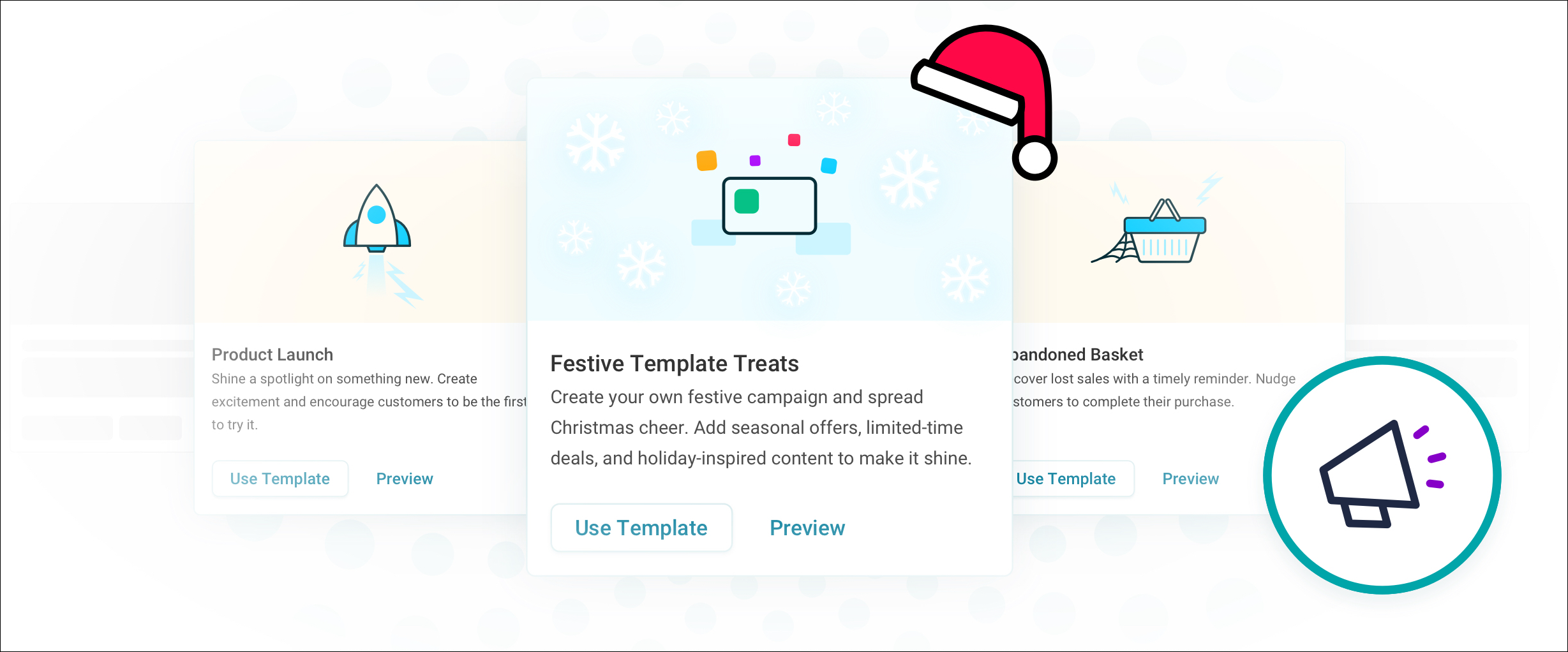
Predefined templates span from simple campaigns through to complex multi-stage journeys. Custom templates allow you to standardise campaign structures and make them available to your team or clients.
Key capabilities:
-
Preview template structure and journey steps before applying
-
Save any existing campaign as a reusable custom template with description notes
For more detail, see Journey templates.
New features and improvements
Connect
Custom attributes now inherit source column names
When you create a custom attribute and assign it to a contact point in Orbit connect, it automatically inherits the source column name. You can keep the inherited name or edit it to suit your needs.

For more detail, see Attributes.
Analyse
Dashboard number tile enhancements
You can now use audiences and FastStats selections as measures on number tiles, allowing you to display customer segment counts directly on your dashboards.
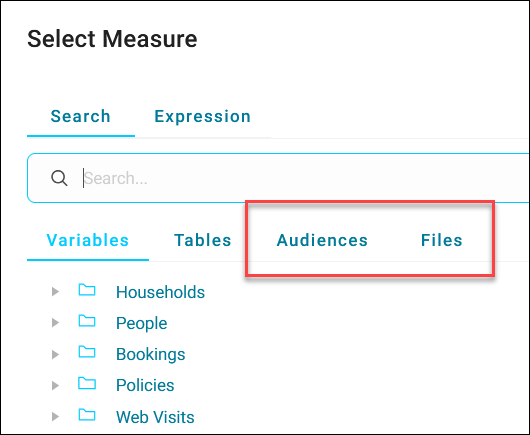
You can also compare measures against audience or selection counts, and then display the percentage difference between them.

Use the new Include Filters toggle to control whether or not your comparison audience count respects or ignores dashboard, user, tile, and measure filters. When disabled, the audience count remains independent, regardless of any filtering applied to your dashboard, providing a consistent baseline.
Note: The comparison applies to the records being counted, not to the audience definition itself.
For more detail, see Number tiles.
Dimension and measure filters in dashboards
You can now apply filters to dimensions and measures in dashboard tiles, giving you the same filtering capabilities available in audience workbooks.
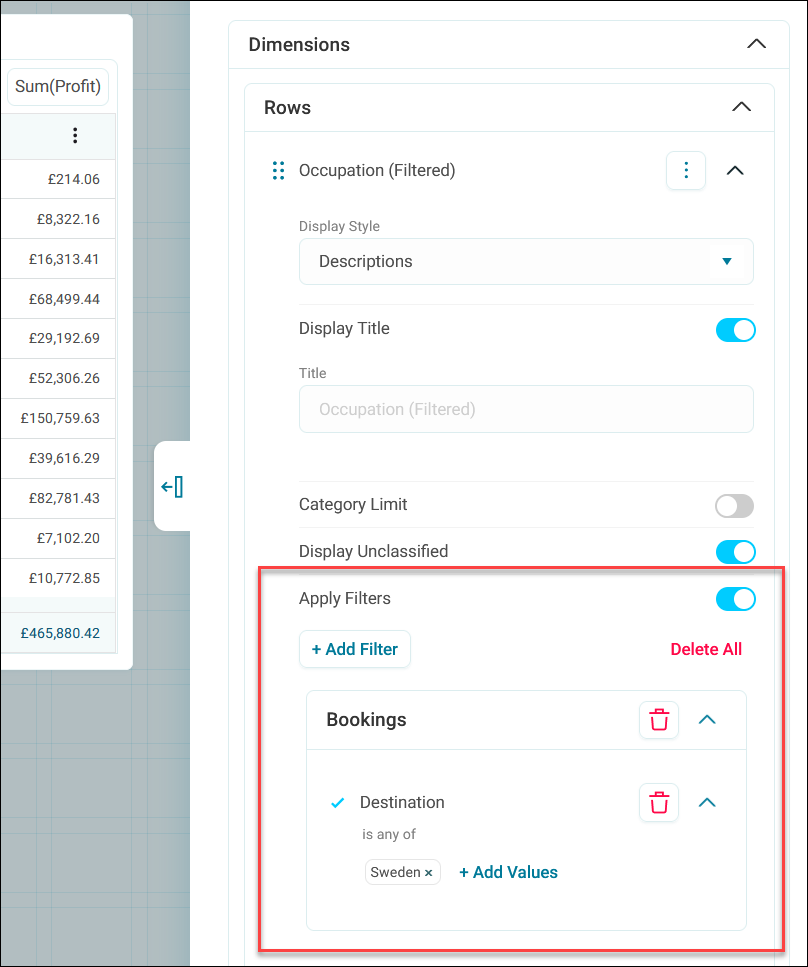
These new filtering options work when you:
-
Drilldown into your data
-
Apply tile selections to user filters
-
View underlying filter logic
You can add audiences as measures in your dashboard tiles, helping you analyse audience segments alongside your standard metrics.
For more detail, see Tile filters.
Help links added to map definitions settings
The Map Definitions page in Application Settings now includes direct links to resources for installing boundary map files. These files enable map visualisations in dashboards and audiences.
If no map definitions or files are currently available, then click Read Help Centre Article to access installation guidance. On the Upload Shape Files tab, a new link allows you to browse and download free map files from the Apteco portal.
Bug fixes
-
We’ve fixed an issue preventing you from scrolling in the File Server Admin section of Application Settings.
-
Maps on dashboards no longer unexpectedly change position or zoom level after saving.
-
We’ve fixed an issue where dashboard filters displayed the table name rather than the configured plural name.
-
Referenced audiences no longer appear unlocked without displaying dashboard dependency warnings.
-
We've fixed an issue where automatic translations removed spaces from filter labels in dashboard tile queries for some languages.
27 November 2025
Version 2.1.43
Headline feature: Profile tiles
Profile tiles in Orbit dashboards help you discover what distinguishes your target audience from your broader customer base. By comparing an analysis group against your universe or filtered dataset, you can identify the characteristics that make this audience unique. Use these insights to create targeted campaigns, build personas, or better understand your customers.
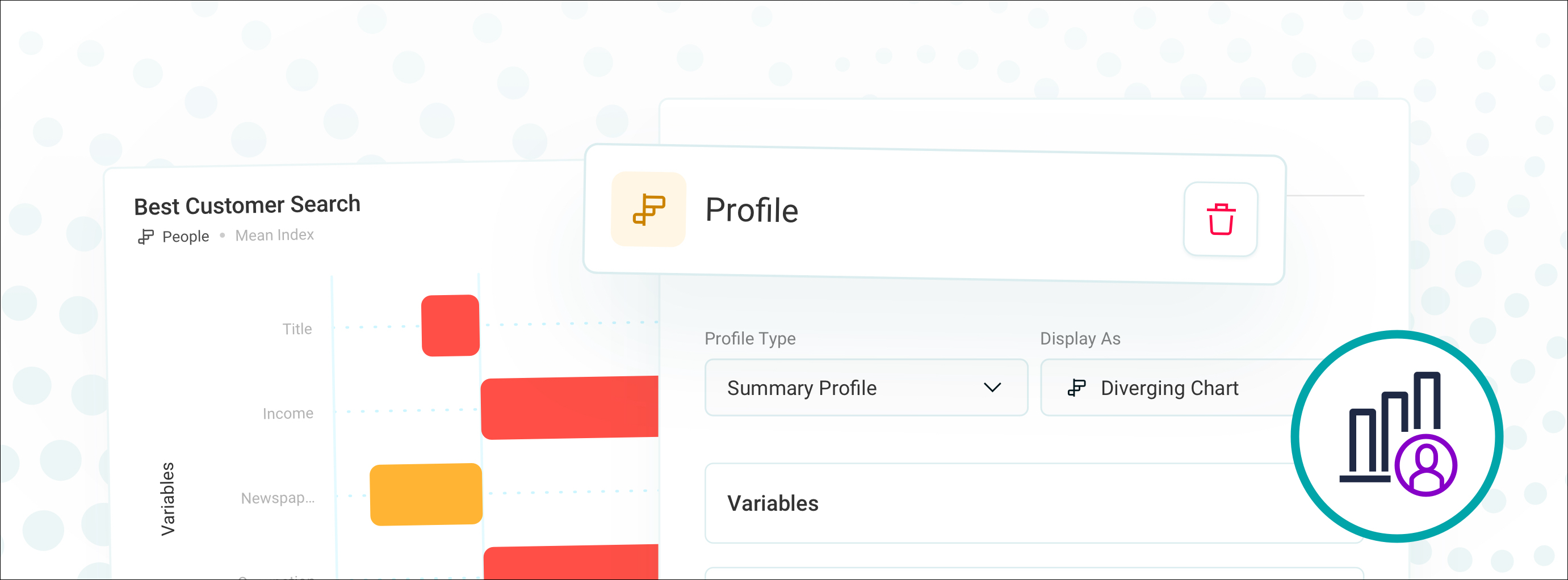
Profile tiles offer six distinct profile types, each designed for specific analytical needs:
-
Three summary profiles analyse multiple variables simultaneously to identify your most significant characteristics.
-
Three detailed profiles break down individual variables into categories to reveal specific patterns.
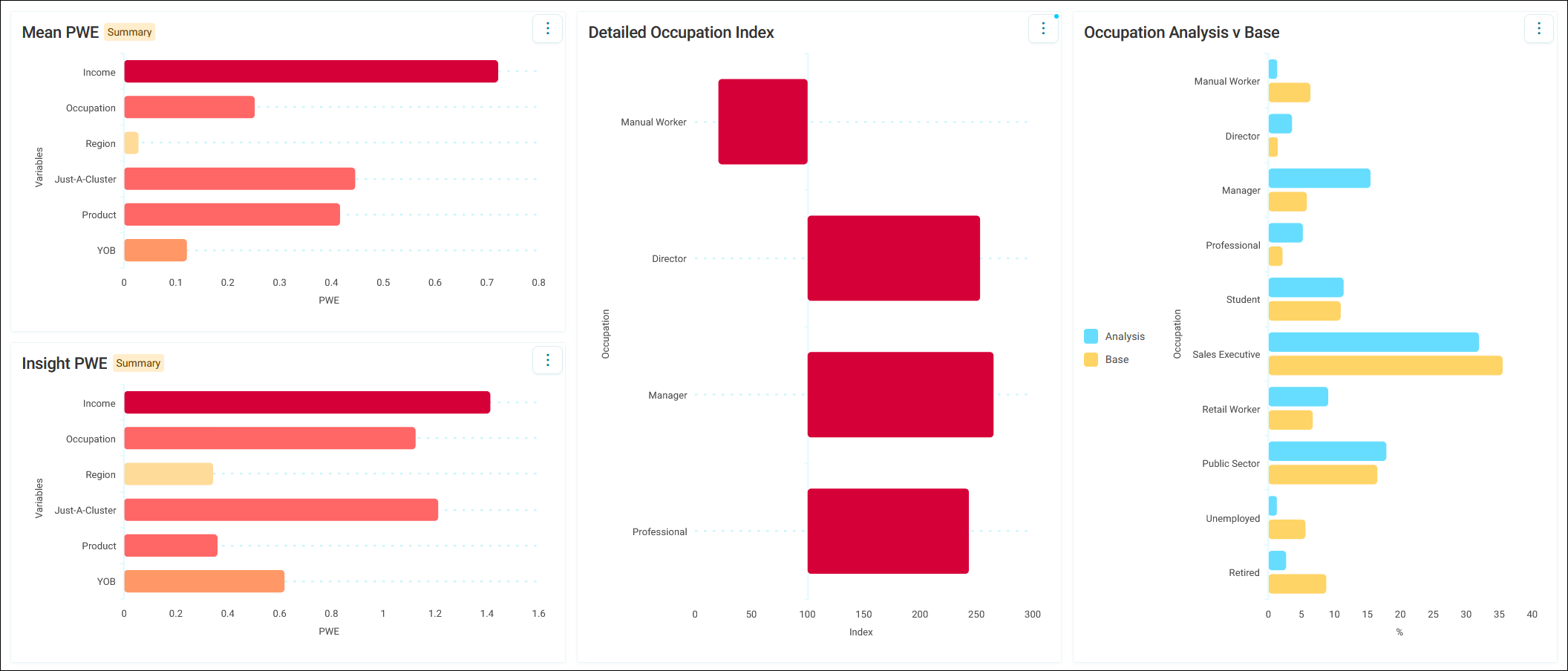
Other key capabilities:
-
Configure display limits to focus on the strongest indicators
-
Apply confidence shading to visualise statistical reliability
Note: Profile tiles require an analysis filter to define your target audience. Analysis filters are a special filter type that only affect profile tiles on your dashboard.
For more detail, see Profile tiles and Analysis filters.
Bug fixes
-
When comparing a 31-day month with a previous month that has only 30 days, number card comparisons with the previous period now calculate correctly.
-
System lookups now display correctly when you add a favourite cube to an audience that doesn't include the cube's variables.
-
When a time delay starts the following redirect section, a path redirect step no longer shows the audience count.
-
The display setting for calculated measures now keeps the calculation as percentage option after you save, refresh, and reopen the dashboard.
-
Results from a Venn dashboard tile now display correctly when you copy a tile to a dashboard that already contains a Venn.
19 November 2025
Version 2.1.42
Headline feature: Personalise campaigns with voucher codes
You can now include unique voucher codes in campaign messages. Upload your code sets to Orbit and reference them through personalised messages in the journey builder.

When you select a code set in a channel step, the system shows how many codes are still available. Orbit tracks voucher code set totals and remaining codes as they’re used. This helps you plan and monitor promotional campaigns that depend on limited-use incentives.
Administrators must first upload CSV or TXT files through Application Settings > Voucher Codes.
Voucher codes display:
-
Total codes in the set and any remaining unused codes
-
Upload and usage history to help code management
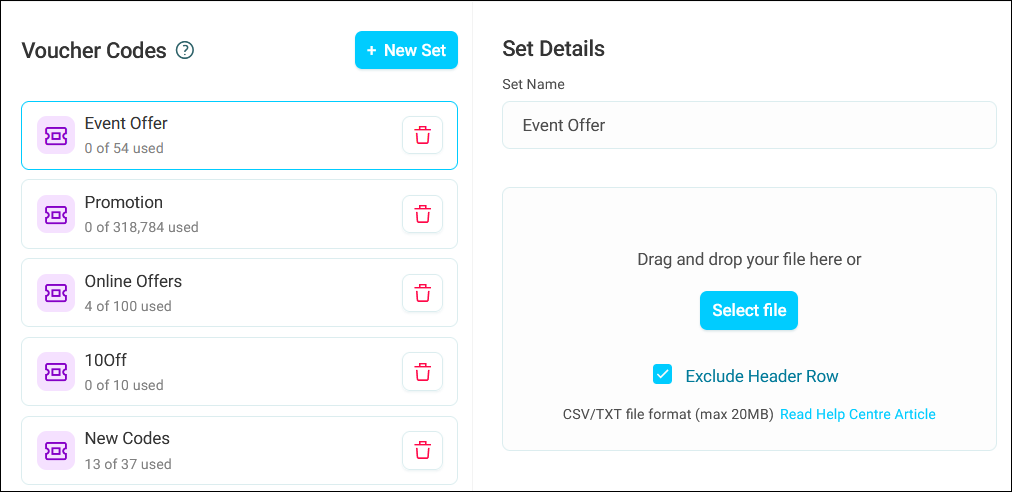
Note: Voucher code management and the ability to view upload history requires Apteco software version Q3 2025 or later. Access to upload and manage voucher code sets requires Orbit Administrator rights or the Voucher Editor permission.
For more detail, see Voucher codes.
New features and improvements
Analyse
Pivot cube dimensions
Dynamically reorganise your cube visualisations by swapping row and column dimensions.
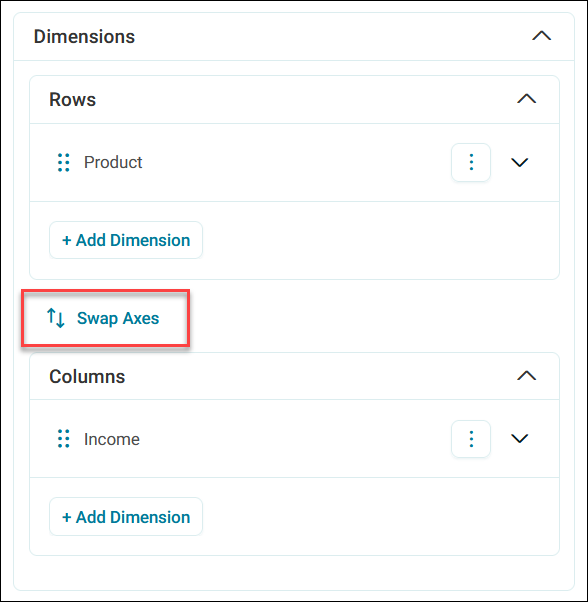
The new Swap Axes button allows you to quickly alternate between different data perspectives without rebuilding your cube. This functionality is available in both dashboards and audiences.
Note: This functionality is only available to users who can edit a cube.
For more detail, see Dashboard cubes.
Select an audience as a measure on cubes and charts
You can now add audiences as a measure to cubes and charts in audience workbooks, alongside variables and tables.
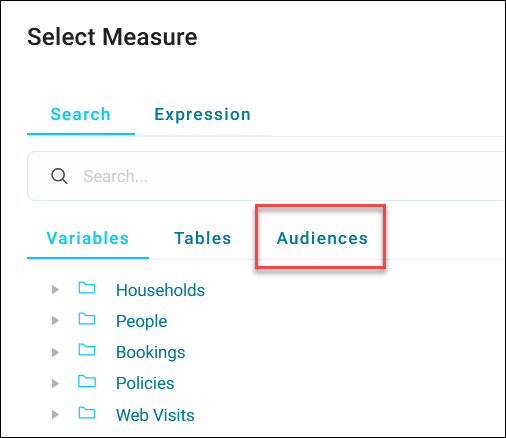
View your audience counts alongside your other measures to compare audience membership with dimensions and standard metrics in a single cube view. You can then select multiple cells within the cube and create a new audience.
For more detail, see Working with measures.
Select specific measures in audience workbooks
You can select a specific measure when creating audiences from cubes or charts that contain multiple measures. This gives you more control over which metric drives your audience creation.
Improved dashboard tile layouts across devices
Dashboard tiles now display more effectively across laptop and tablets with updated default sizing. These changes reduce white space and create cleaner, more balanced layouts without manual adjustment.
Note: This change applies to newly created tiles only. Existing dashboard tiles retain their current layout settings.
Campaign
Export campaign journeys as PDF
You can now export a campaign journey as a PDF. The export captures the full journey layout, including audience counts at each step. This helps you share journey designs with colleagues, include them in documentation, or review journeys outside Orbit.
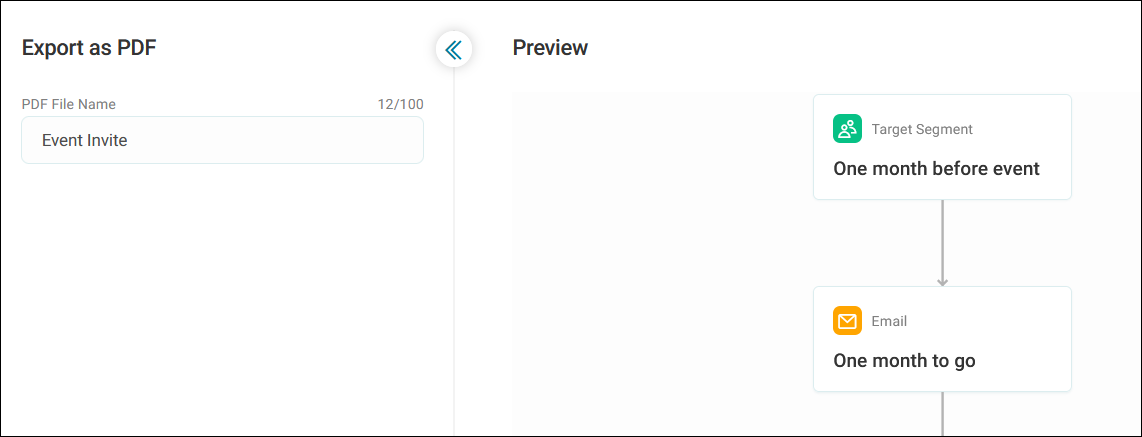
For more detail, see Export journeys as PDF.
General
Orbit system theme
A new Orbit system theme option called Orbit Default is now available in Application Settings and provides clearer contrast and readability. The updated theme applies a revised colour palette across your workspace, with charts, cubes, and data grids automatically adopting the new colours.
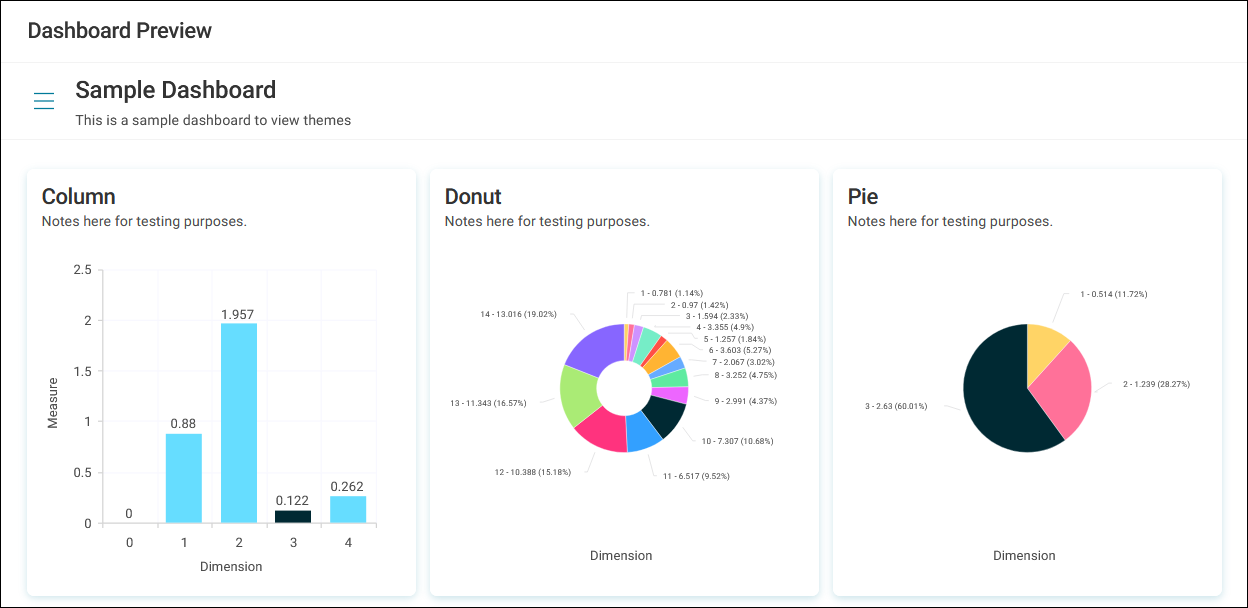
Bug fixes
-
Custom field titles in Export Data solutions now require valid column headers before you can apply changes, preventing custom code from appearing without proper identification on data grids.
-
Dashboard map tiles with index shading now use the 'whole universe' as the base filter by default, ensuring consistent shading appears without requiring user filters.
-
Calculated measures displayed as percentages now display correct percentage calculations instead of the raw calculation result.
-
We’ve fixed an issue where chart tiles displayed duplicate axes when using negative expression values as measures.
30 October 2025
Version 2.1.41
Headline feature: Extend your Apteco data model with custom attributes, permissions, and suppressions
You can now extend your standard Apteco data model with custom attributes and manage contact preferences through permissions and suppressions. Attributes store additional data directly against contact records, like individuals, or specific contact points such as email addresses and mobile numbers. Unlike User Defined Tables (UDTs), attributes integrate seamlessly into your data model, allowing any data source to update them while maintaining a single, current version.
Permissions and suppressions provide granular control over contact preferences. Permissions grant the right to contact someone through a specific channel, while suppressions prevent contact. Both maintain complete history to support compliance requirements.

Key functionality:
-
Create custom attributes with flexible data types (text, numeric, date, currency, selector) and organise them into folders
-
Map permissions and suppressions to specific contact points to enforce contact preferences across all channels
-
Use attributes, permissions, and suppressions immediately in audience selection to filter and segment your data
For detailed documentation, see Attributes and Permissions and suppressions.
New features and improvements
Connect
Amazon Redshift as a data source
You can now use Amazon Redshift as a data source in Orbit connect. This integration lets you import data from your Redshift databases and use it to build your Orbit system.
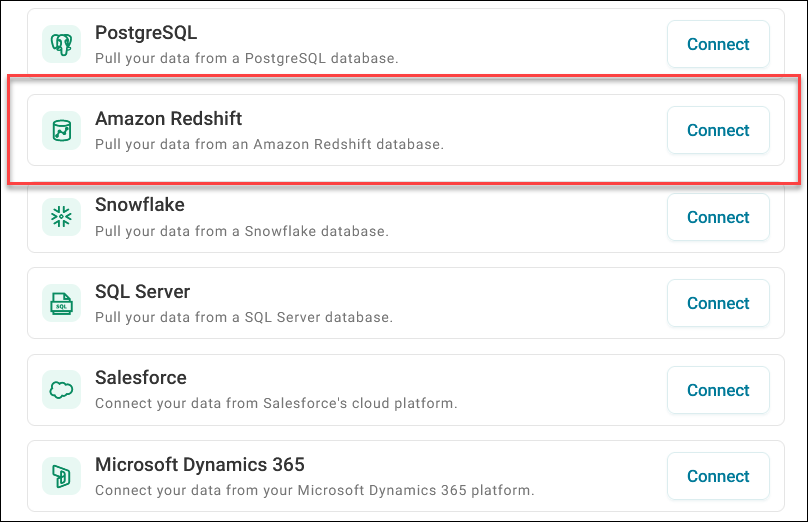
This feature expands your database data source options alongside PostgreSQL, Snowflake, and SQL Server, giving you flexible database connectivity for diverse data integration.
Orbit connect also now allows the creation of both Customer Data Tables (CDTs) and User Defined Tables (UDTs), meaning you can use your Amazon Redshift data source in conjunction with our upcoming major feature release, Apteco CDP.
For more detail, see Database connections.
Analyse
Add profile models to data grids in look-alike audiences
You can now add profile models to data grid columns in look-alike audiences, alongside standard variables. This feature lets you display profile model scores alongside your audience data.
Campaigns
Flexible message selection in interaction splits
Interaction splits can now reference any channel step in your journey, not just the preceding one. This allows you to reference earlier messages for engagement measurement, then add subsequent splits based on later messages. This enhancement supports more sophisticated segmentation without restructuring your journey.
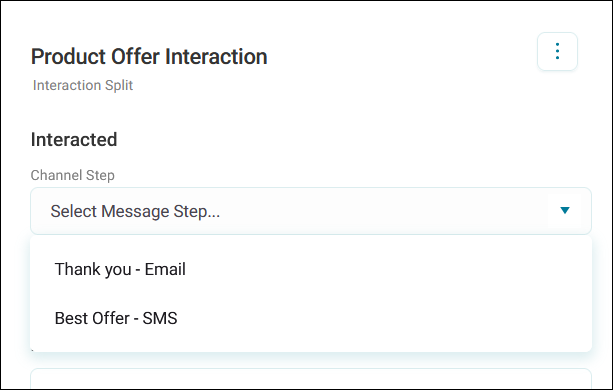
This update supports the following channels types:
-
Email
-
SMS
-
WhatsApp
When switching between channels, supported interactions persist whilst unsupported ones are removed, allowing confident multi-channel experimentation.
For more detail, see Interaction splits.
Bug fixes
Connect
-
Orbit systems built with the Apteco CDP no longer include additional and unpopulated values in the Gender variable.
-
We’ve updated the UI messaging when adding User Defined Tables to your system design in Orbit connect to display correct text for tables containing reference variables.
-
Question mark tooltips in table properties and relationship properties now link to online help documentation.
-
Dropdown lists now remain open when you interact with overlaid modals or popup notifications.
-
Language settings now persist correctly when you open Orbit connect, displaying the appropriate flag based on your chosen Orbit language instead of defaulting to US English.
Analyse
-
Duplicating audience favourites now preserves the resolve table name and type correctly.
16 October 2025
Version 2.1.40
Headline feature: Ordering by nominal variable for N Per audience limits
You can now define custom priority orders for nominal variables when applying N Per limits in audiences. This improvement ensures that you consistently select records that match your business priorities, even when working with unordered data.
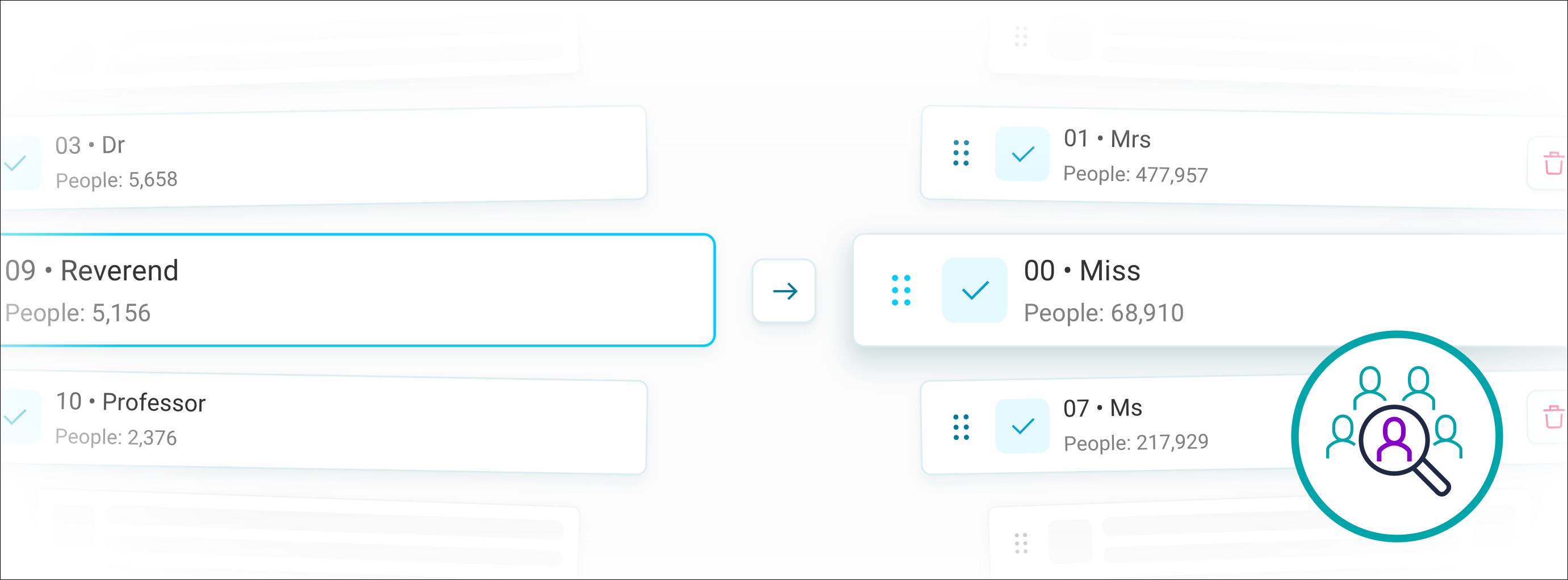
When you apply an N Per limit, you can now order nominal variables such as town, region, or mobile provider. The system then prioritises records based on your chosen order while including other values when your priority items are exhausted.
This ordering works alongside existing sequencing for other variables, giving you complete control over which records appear in your audience based on what matters most to your campaign.
For more detail, see N Per limits.
New features and improvements
Analyse
Numeric reference variables in audience limits
URN variables defined as numbers are now available to use in your audience limits to order results by URN for both sample and N Per limits.
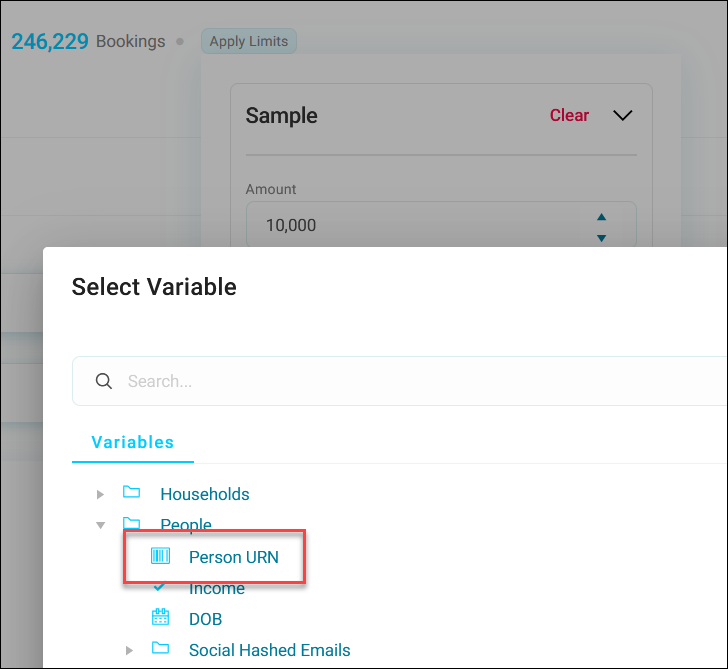
For more detail, see Applying limits.
Export complete data from cubes and tables
You can now export complete datasets from cubes and tables, even when the display shows only partial information due to category or value limits. This feature works in both dashboards and audience workbooks.
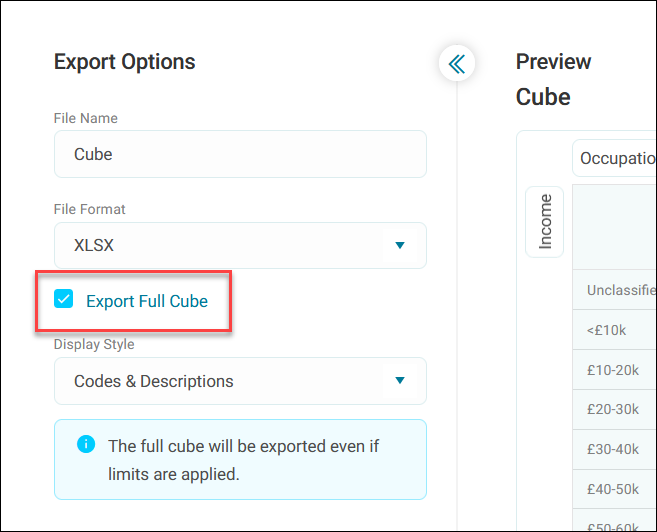
When you export data from cubes and tables, you can choose:
- Partial view export: Exports only the statistics currently visible in the tile.
-
Complete data export: Exports the full dataset, including data not displayed due to category limits or value limits. Use XLSX or TXT format to access all data.
For more detail, see Exporting an audience workbook cube.
Note: Data grids always export the complete dataset matching the applied filter. See Exporting data from an audience.
Filtering measures and dimensions on charts and cubes
The ability to add filters to cube or chart measures in audience workbooks lets you further refine the data behind each measure for more precise analysis.
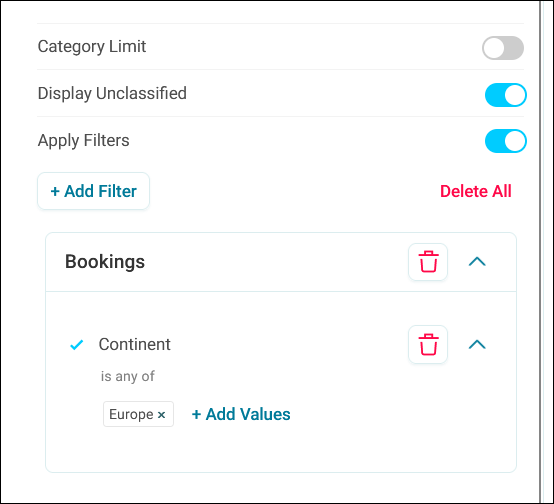
For more detail, see Cubes in audience workbooks and Charts in audiences.
General
Updated expression builder
The expression builder in Orbit now supports the latest FastStats expressions, along with enhanced validation checks.
Note: To use these expressions effectively, we recommend upgrading to Apteco software version Q3 2025.
-
Validation checks
-
Left and Right functions: the 2nd parameter can’t be greater than 32,767
-
SubStr and Mid functions: the 2nd or 3rd parameter can’t be greater than 32,767
-
-
LinearTrend function
-
Use the LinearTrend function to examine increases or decreases over time. For example, to see which products are gaining or losing popularity or value.
-
-
Date and time functions
-
DateTimeConvert(dateTime, sourceZone, destZone) converts between time zones
-
SelectedDays now supports an optional parameter for an exclusion list in YYYYMMDD format as a numeric list
-
SelectedHours is now more efficient and has an optional parameter for an exclusion list in YYYYMMDD format as a numeric list
-
-
Time functions
-
Today, TimeNow, BuildDate, and BuildDateTime now support zero-parameter versions.
-
-
Text list mapping
-
TextListFromFile supports mapping and mapping size parameters
-
TextListMapping is now valid and allows per-record mapping
-
You can find more details on these expressions in the FastStats release notes from 2024 and 2025.
Bug fixes
Dashboards
-
Thematic shading maps automatically adjust the number of range bands based on your filtered data results. Maps with fewer values than the configured ranges (default 10) reduce bands to prevent empty ranges, whilst maps with more values distribute results across the configured number of bands.
-
Category limit text now displays the appropriate unit type when you select Value % or Category % types in pareto tiles, showing percentage values instead of category counts.
02 October 2025
Version 2.1.39
Note: All of the following campaign features require Apteco software version Q3 2025.
Headline feature: Google Ads campaign channel integration
You can now connect your Google Ads account to Orbit and upload targeted audience segments directly to your Google Ads campaigns.

Key functionality:
-
Orbit automatically identifies whether your account is a manager or client account
-
Choose between Upload and Advertise or Upload Only configurations
-
Upload audience lists to manager accounts or directly to specific client accounts for distribution
With this channel integration you can manage campaigns across multiple client accounts whilst targeting audiences using your existing customer data.
For more detail on setting up and using this channel, see Google Ads.
New features and improvements
Campaigns
WhatsApp named parameters for personalisation
WhatsApp now supports named parameters as an alternative to numbered parameters for message personalisation. Orbit supports these personalisation fields in the journey builder, so you can use descriptive variable names like {{Title}} and {{FirstName}} instead of positional references like {{1}} and {{2}}.
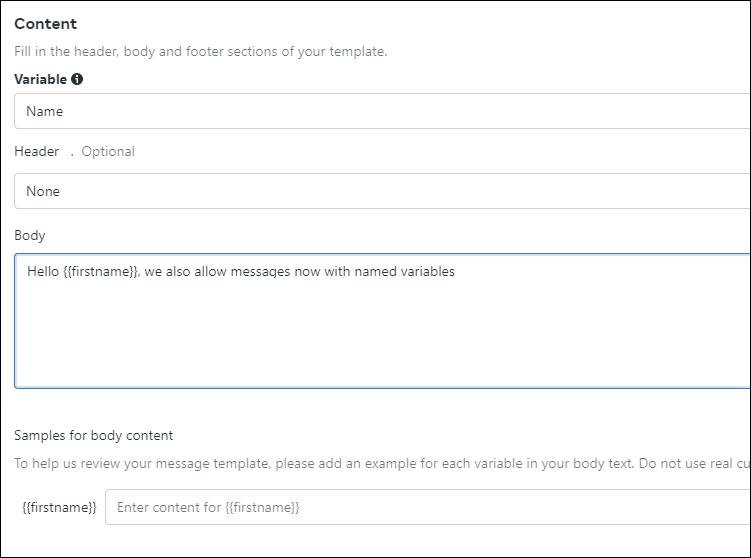
Key functionality:
-
Use descriptive names that match your data attributes
-
Add multiple named parameters to both header and body sections
-
The journey builder identifies named data attributes for personalisation
-
Populate named attributes and refresh preview to see formatted messages
This enhancement makes WhatsApp message setup more intuitive whilst maintaining full support for existing positional parameters.
For more detail on setting up and using this channel, see WhatsApp.
Bot click detection in campaign overview
The campaign overview screen now displays bot clicks in your email campaign performance data alongside your standard click metrics. This enhancement helps you distinguish between genuine user engagement and automated bot activity.
Optional sender details for Apteco email templates
When setting up Apteco email channels, you no longer need to enter a sender name and sender address. Orbit now uses the sender details from your email template when you have not provided channel-level sender information.
Bug fixes
Dashboards
-
You can now successfully create report dashboards from a campaign without generating errors.
-
Table and cube sorting now considers year, month, and day in the correct hierarchical order.
-
You can select rows in data grid tiles and access dropdown options for drilldown functionality when viewing dashboards.
-
Tile type dropdown menus now display available options correctly when you have fifteen calculated tiles on a dashboard. These options allow you to view and change tile types as expected.
-
Hyperlink encoding for full URLs in data grid variables works reliably, ensuring that complete URLs display and function correctly when clicked.
Campaigns
-
You can redirect LinkedIn messages to sections in the journey builder without encountering errors.
18 September 2025
Version 2.1.38
New features and improvements
Connect
Column picker for Microsoft Dynamics 365
You can now select which specific columns to import when setting up a Microsoft Dynamics 365 data source in Apteco, giving you greater control over your data ingestion process.
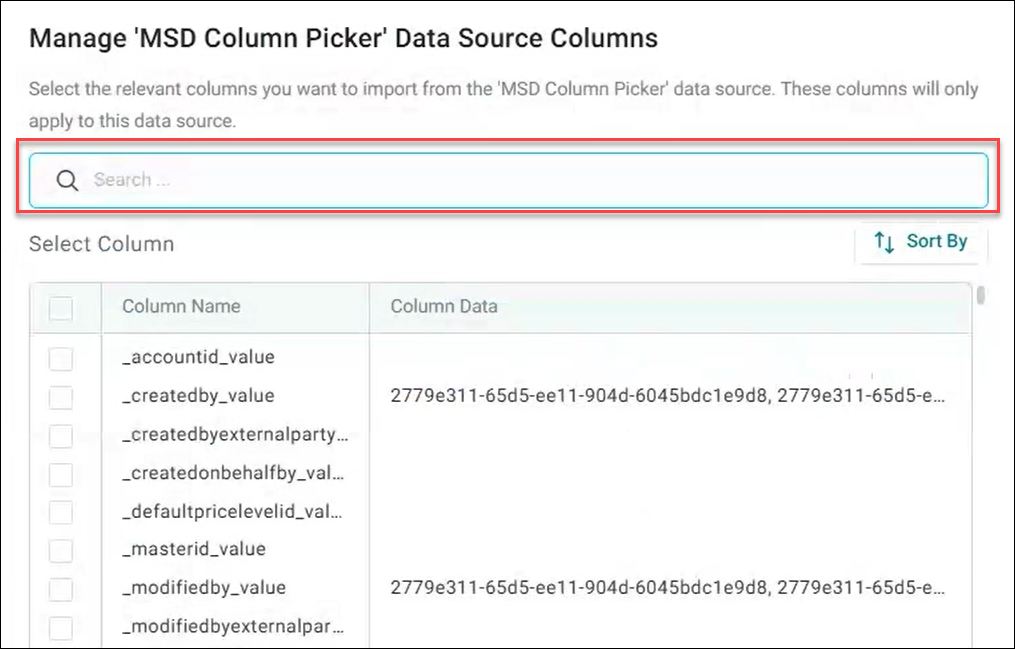
This enhancement saves time when working with Dynamics 365 sources that contain many columns by letting you select only the data you need upfront, reducing time spent on subsequent tasks such as data mappings.
Key functionality:
-
Filter and search through available columns
-
Select columns using checkboxes
-
Add multiple columns before importing
This improvement applies to both Customer Data Tables (CDTs) and User Defined Tables (UDTs) for use with Apteco CDP, which is currently in the Apteco insider programme.
For more information, see Microsoft Dynamics 365.
Dashboards
Text tiles exempt from dashboard limits
You can now add text tiles to dashboards even when you reach the 15-tile limit. This allows you to include any explanatory content without restrictions.
Bug fixes
Dashboards
-
Venn diagram filters now select the correct segment when you use measures from different tables, rather than selecting the entire set.
-
You no longer encounter an 'unsaved changes' error message when switching a number card to another chart type.
-
An error is no longer generated with Tables/Sparse Cubes when using Mode(Cost) as a measure with a value limit.
28 August 2025
Version 2.1.37
Headline feature: Custom queries for Salesforce data sources
When uploading your Salesforce data source using Orbit Connect, you can now create highly specified queries to define your columns and rows of your Salesforce data.
Prior to release of Salesforce data source custom queries, you were limited to returning all rows and a full set of columns from your Salesforce data source - You no longer have this limitation.
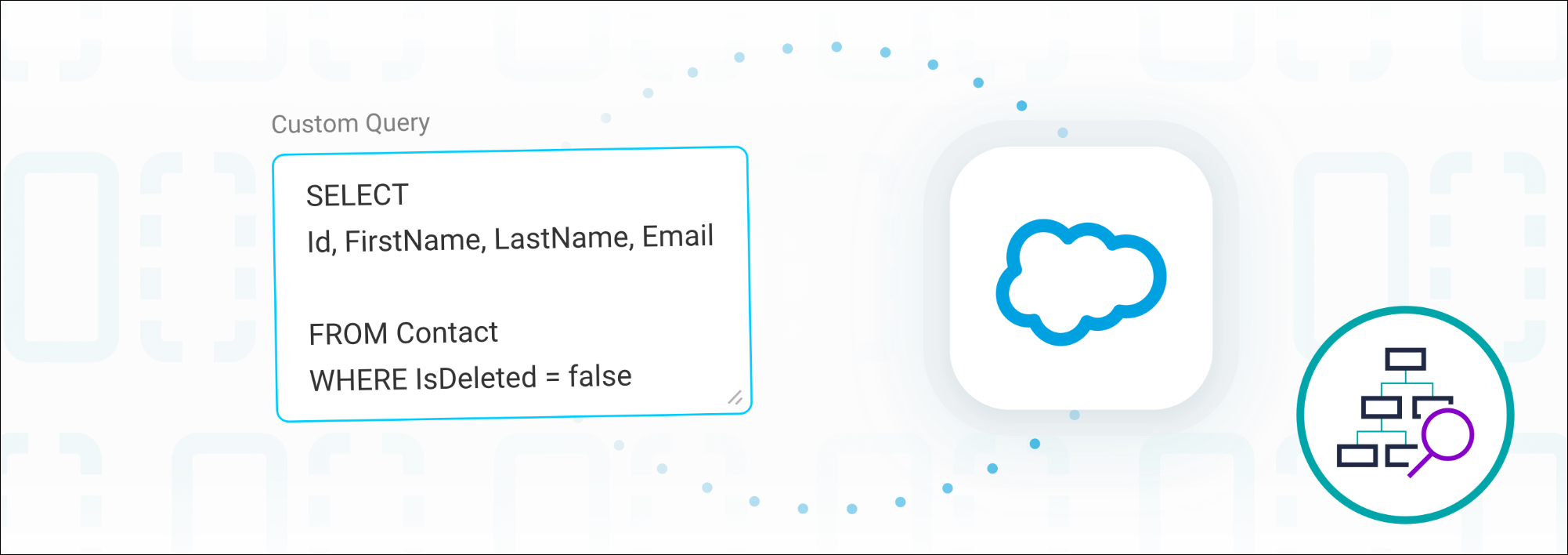
This powerful functionality allows you to:
-
Apply filters to your data returned (using a WHERE clause)
-
Refer to columns from ancestor tables
-
Transform the data you retrieve
Custom queries provide the flexibility and control of SOQL (Salesforce Object Query Language) statements to precisely define the Salesforce data columns and rows that you upload to your Apteco Orbit system.
See Custom queries.
New features and improvements
Connect
New deduplication rules implementing Cologne Phonetics
We've introduced a new deduplication rules algorithm, Cologne Phonetics, to our ID resolution rules. Cologne phonetics is very similar to Soundex but optimised for the German language.
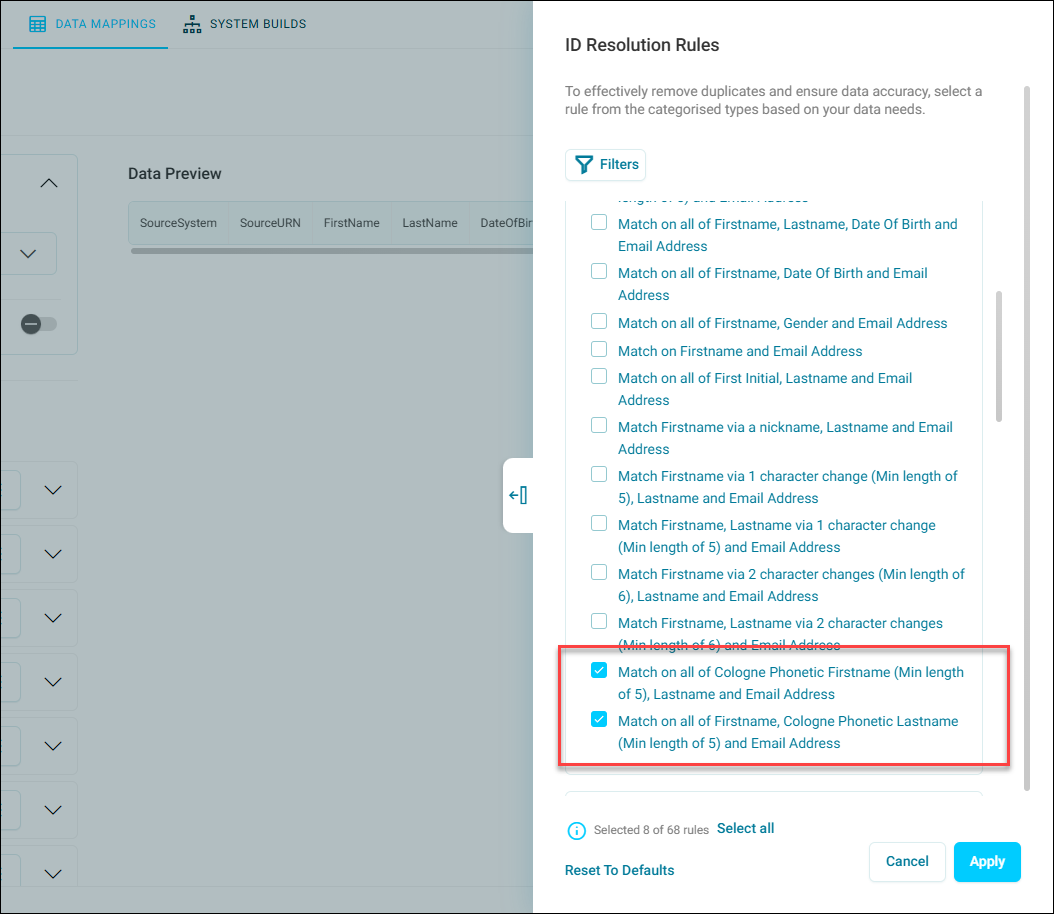
Bug fixes
Dashboards
-
You can no longer duplicate dashboard tiles if doing so would exceed the 15-tile limit, avoiding dashboard save failures. The duplicate option becomes unavailable when you reach maximum capacity.
-
You can now cancel out of dashboard edit mode without removing any search or pre-defined filters that you've applied.
-
Selecting from a tile with category limits no longer incorrectly chooses the wrong categories.
-
2D charts now retain the second dimension when you edit the first dimension, preventing data loss during chart configuration. Fixed in both dashboards and audiences.
-
Category displays now show accurate counts that exclude unclassified items when they are not used.
-
Venn sets no longer show configuration warnings when they are set up correctly.
-
2D charts now save custom legend names correctly in both preview and saved views.
Audiences
-
When you create two audiences and then save the second audience - it now displays the appropriate count, rather than incorrectly displaying the count of the first audience.
General
-
We've fixed an issue preventing currency values from being correctly displayed when set to an Irish locale (en-ie).
13 August 2025
Version 2.1.36
Bug fixes
Dashboards
-
We’ve fixed an error occurring when filtering a dashboard via a pareto tile. When you refreshed a dashboard with a pareto tile and a number card (or any other visualisation), and clicked any part of the pareto to a filter, an error message was generated.
Audiences
-
We've introduced an improved folder selection dialog that lets you choose any folder to store your campaign, when creating a campaign from an audience. With these improved selection options you can now also select the root campaigns folder.
-
You can now successfully create favourites from an audience and load existing favourites without generating an error message.
-
Unused look-alike variables are no longer automatically selected when you first create your look-alike model. This issue could occur, for example, if you calculated five variables but only selected the top three for your look-alike audience, all five variables were then incorrectly selected.
08 August 2025
Version 2.1.35 (Out-of-band-release)
Bug fixes
Dashboards
-
We’ve fixed a crash that could occur under certain circumstances with dashboard tiles that use value limits, where users would encounter a 'Method not implemented' message.
This issue could affect tiles where the value limit had been set manually, or where a text variable had been used as a dimension, forcing you to use a value limit.
06 August 2025
Version 2.1.34 (Out-of-band-release)
Bug fixes
Dashboards
-
Number tiles now accurately display comparison values. This resolves an issue causing comparison periods to display identical values to current periods, particularly on month-end dates.
-
Table drill-downs now correctly filter data when you’ve applied multiple filters. This resolves an issue causing drill-down to incorrectly reference original table positions, instead of filtered row positions.
-
Category display now handles maximum category selections without crashing.
-
Combo charts and tables now correctly handle measure function changes, fixing crashes when you change a cost measure from sum to mean.
-
Stacked column charts now correctly handle measure changes, without causing an error.
-
When you change a resolve table it now updates its records accordingly and allows you to save the new results via the side panel menu, as expected.
31 July 2025
Version 2.1.33
Headline feature: LinkedIn in Orbit
Orbit now integrates with LinkedIn, enabling seamless campaigning with LinkedIn Ads.
With Apteco LinkedIn, you can upload audience data and target specific contacts or companies directly from Orbit.

Once integrated, LinkedIn organises campaigns through three Campaign Manager levels:
-
Campaign Group: Define your campaign objective or purpose
-
Campaign: Define your audience and filters, budget, UTM tracking, type of ads, and the start/end date for your campaign
-
Ads: Create ads which LinkedIn delivers to your audience
Orbit connects with LinkedIn at campaign level, with your audience inclusions and exclusions to accurately target your potential customers.
For more information, see LinkedIn.
New features and improvements
Dashboards
Orbit selector variable column controls
You can now customise which columns are displayed in the selector categories pick list panel, and adjust widths to optimise the viewing experience and allow greater visibility of information.

This allows you to adjust your variables so they fit your screen and analysis purposes. These settings persist between sessions and are held on a 'user per system' basis for all variables.
Pan and zoom when filtering maps in view mode
You can now maintain pan and zoom when filtering maps in dashboard view mode.

This functionality allows you to zoom in on densely populated maps for more precise selection analysis.
See Pan and zoom.
Campaigns
Repositioned filtering and sorting campaign controls
Filtering and sorting controls have moved from the left side menu to the top-right corner as expandable icons with dropdown menus, giving you more space to view your campaigns and folders.

See Filtering and searching campaigns.
More detail added on ToDos
If your ToDo is regarding a particular named journey step, then we now show the name of this journey step in your ToDo. This improvement is particularly helpful if you have multiple actions to complete on multiple steps of the same type.
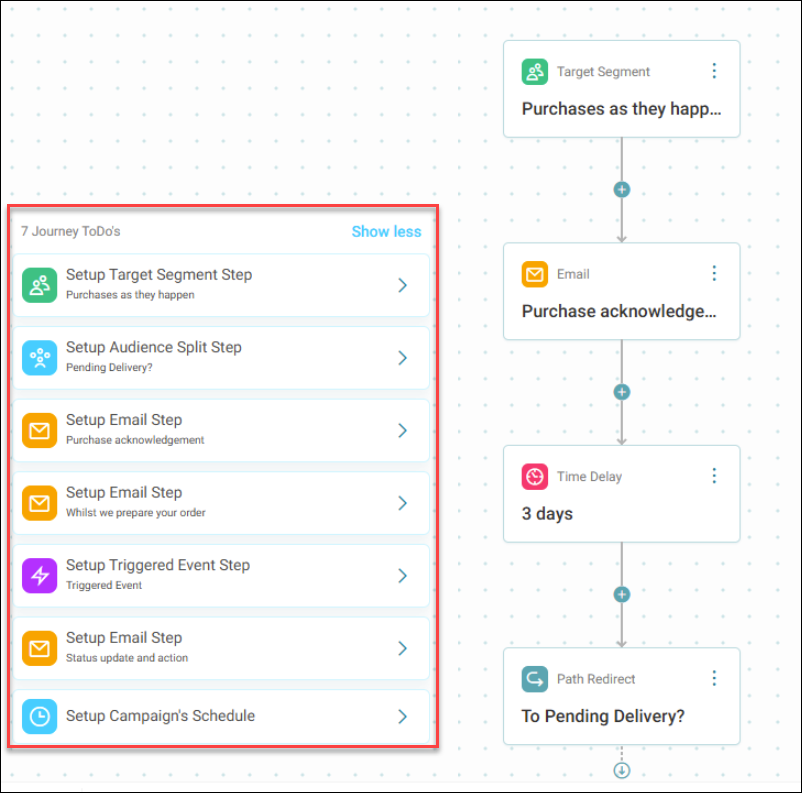
Enhanced campaign calendar list view
We’ve expanded the campaign calendar list view with additional columns and more comprehensive information.
The expanded list view now includes:
-
Date and time
-
Campaign name and folder location
-
Last run date
See Campaign calendar.
List view of campaign folders
You can now display a list of all the folders and campaigns saved within your chosen root folder.
With this list view improvement, you can:
-
Create campaigns or new folders
-
View folders and campaigns in a list
-
Access folder and campaign actions via an action menu
-
Toggle between tile and list views, with your selected view persisting in your current session
Bug fixes
Audiences
-
Exporting data grids with variables across different tables now generate correct results, as expected. For example, on a 'Person' audience with person and policy variables, this issue prevented the policy columns from being fully populated when exporting.
-
Duplicating an audience with an export analysis no longer generates an error message.
Dashboards
-
When turned on, dashboard chart legends are now centrally aligned by default on the tile.
-
When you edit a dashboard, the save button is no longer automatically enabled. The save button is now only enabled when you edit a dashboard and make a change.
16 July 2025
Version 2.1.32
New features and improvements
Audiences
Show rows with no transactions in data grids
You can now display records with no transactions in audience data grids.

This means that you can:
-
More clearly view records that don't have transactions
-
See parent table rows, even when there's no transaction data in other tables
This option is available via both table view and data grid exports.
Improved workbook favourites
We’ve improved the efficiency and user experience of workbook favourites management:
-
Implemented search and filter capabilities within the favourites panel
-
Enabled renaming, duplicating, and sharing of favourites
-
Removed archiving functionality, replaced with a straightforward delete mechanism
Combined menu for export/data grid in audiences
We’ve combined the data grid/export item menu functions. The entry route has remained so you can still create, browse, and export but there’s always a data grid analysis item under the hood.
This update further aligns the audience editing panel with dashboards and Orbit design principles. We’ve also changed the ‘Edit’ columns to ‘Properties’, so they’re consistent with the rest of audience workbooks.
Dashboards
Enhanced dashboard map tiles
Analyser bundle licence holders can now use enhanced dashboard map tiles with zoom and pan functionality.
Campaigns
Template-only access for Apteco email
If your system has an Apteco email channel configured, you can access the template builder from the home screen for creative template building only, without a Broadcaster bundle or campaigning licence.
General
Replace old instances of old typography with new ones
We've removed any instances of old typography, and replaced them with new ones. This means that fonts and text have been further standardised across Orbit.
Orbit Terms of Use prompt
You may now encounter an ‘Terms of Use’ prompt when you log in to Orbit.
This prompt is based on the terms of use requirements included in your Orbit licence, and applies to our new AI assistant Orin, who you can read more about here.
Continued use of Orbit necessitates acceptance of these updated Terms of Use. For further information on our updated Terms of Use policy, please advise your system administrator to contact our Technical Services team.
Bug fixes
Connect
-
We've fixed a bug preventing you from saving your UDT data mapping table once you've opened and adjusted the extended settings for currency variables.
-
You no longer encounter an error message when uploading data/importing a file with nested delimiters.
Campaign
-
Non-numeric expression validation now clears correctly when you paste valid string expressions over invalid ones in campaign personalisation and dashboard filter fields.
Dashboards
-
Dashboard tiles with a date dimension, value limit, and tile filter now display all results, as expected.
-
The ‘return all values’ checkbox now remains selected when you re-edit a dashboard cube.
02 July 2025
Version 2.1.31
Headline feature: Microsoft Dynamics 365 as a data source
You can now specify, connect to, and ingest data from a Microsoft Dynamics 365 data source with Apteco, on a manual or scheduled basis.
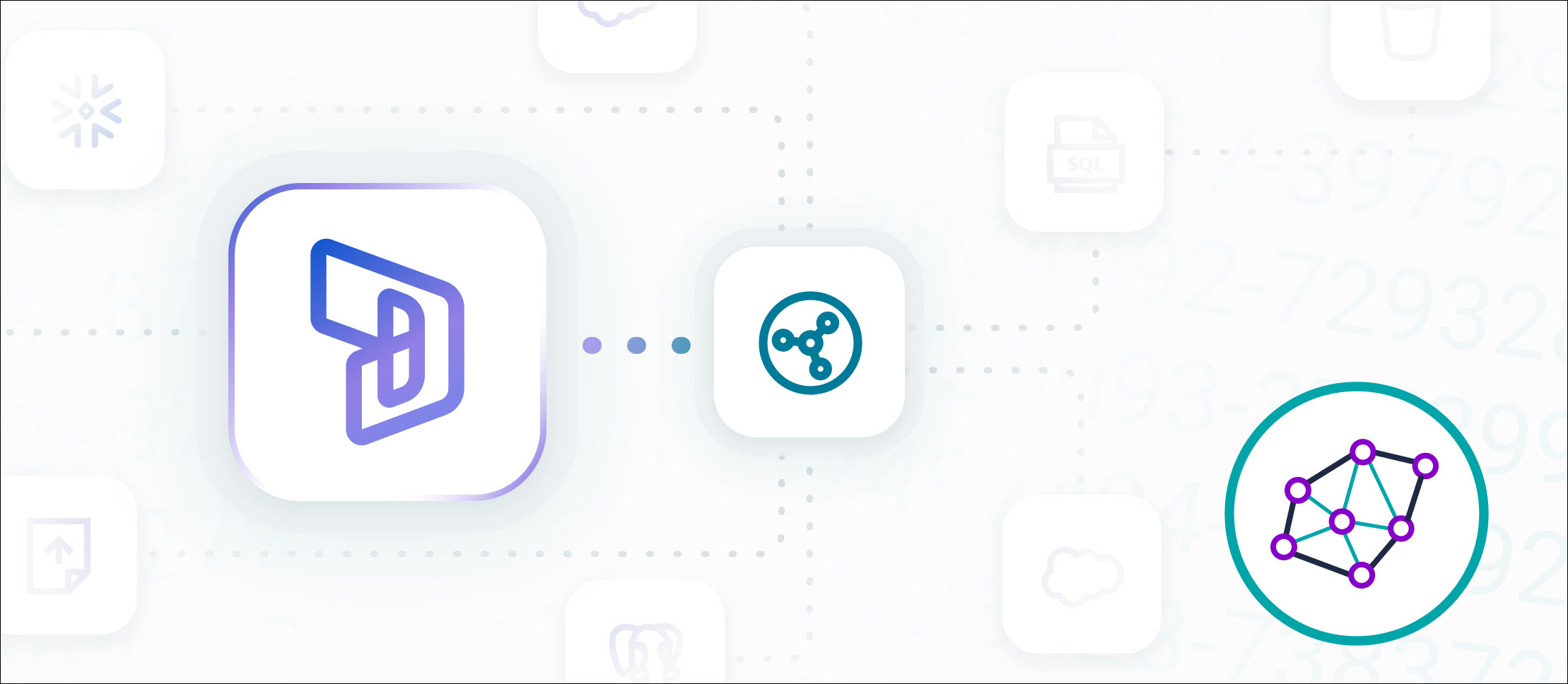
Orbit connect also now allows the creation of both Customer Data Tables (CDTs) and User Defined Tables (UDTs), meaning your Dynamics 365 data source can be used in conjunction with our upcoming major feature release, Apteco CDP.
For more information on Dynamics 365 as a data source with Apteco, see:
Complete Microsoft Dynamics 365 integration
Combined with our June 5th release of Dynamics 365 channels in Orbit campaigning, Apteco now offers an end-to-end Dynamics 365 integration. You can import your Dynamics 365 data, apply flexible field mapping in the channel editor, and then use Orbit campaign journeys to upload audience data back to your Dynamics 365 system.
For more details, see Microsoft Dynamics 365.
New features and improvements
Campaign
Export campaign audience counts
You can now export campaign volume data from a target segment journey step. This feature lets you share gross, net, and limit counts from your campaigns for information or review purposes.
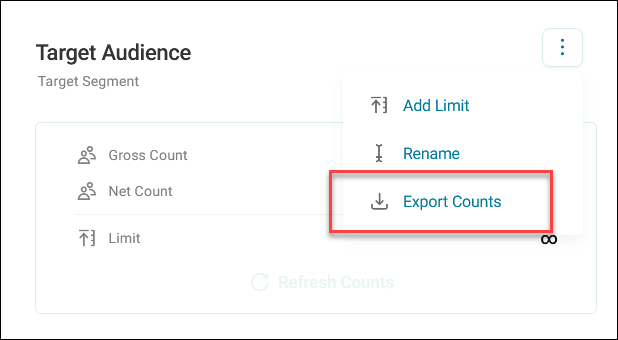
The exported .xlsx file includes count types and values in waterfall order, with exclude segments followed by include segments arranged from top to bottom as they appear in your campaign flow.
See Audience counts.
View last run campaign activity in calendar view
Your calendar now shows both upcoming campaigns and completed campaigns with their last actions and run dates. This gives you a complete view of your campaign activity across your chosen timeframe.
You can now track when campaigns last ran alongside your scheduled campaigns, helping you understand your complete communication timeline and review activity by day, week, or month.
See Campaign calendar.
Navigate to moved or copied campaigns
When you successfully move or copy a campaign, you can now navigate directly to it through a confirmation message with a link to the new location.
See Moving a campaign.
Updated template builder UI
The template builder interface now clearly shows which features are available based on your Apteco licence type.
Available features by licence:
-
Apteco email: Email builder, form builder, landing pages, image gallery
-
Apteco SMS: SMS builder
See Template builder.
General
Transfer Resource Ownership
Transfer Resource Ownership allows your system administrator to move resources (audiences, dashboards, collections, workspaces, favourites) from one user to another.
Note: Please use this feature with caution. Once you transfer ownership of a resource, this can't be undone. If misused, this feature can negatively affect a user’s Orbit instance.
Bug fixes
Analyse
Dashboards
-
You can now edit a dashboard tile on an iPad or tablet, as expected. These devices now always display the dashboard action menu as per the Orbit mobile device responsive view.
-
When you delete a dashboard theme or logo and refresh your browser, the dashboard no longer generates a 'default tab' error message.
-
For German and French language locales, editing a calculated measure no longer causes the 'Display as' function to be reset to default English language.
-
Dashboard tile percentages now maintain their original calculation settings and no longer automatically change to "percentage of column".
23 June 2025
Version 2.1.30 (Out-of-band release)
New Business Date option on a dashboard tile: Error when filtering via selections
We’ve found and fixed an error generated under certain circumstances when using the following feature from our last Orbit release on 17/06: ‘Business date banding can be used for dimensions’.
This error occurred when you added a business date banding as a dimension, selected the banding, then added the selection as a filter in dashboards.
Note: If you have auto-update turned on for Orbit, then the patch will update automatically. If not, please refer to the software releases page on the Apteco portal to download the latest version of Orbit.
17 June 2025
Version 2.1.29
Headline feature: Salesforce as a data source
Unlock the full power of your Salesforce data with Apteco, by adding Salesforce as a data source.
Now available by default, you can specify credentials and import data from your Salesforce environment. These credentials can be used to configure new data sources, selected from the list of available Salesforce objects.
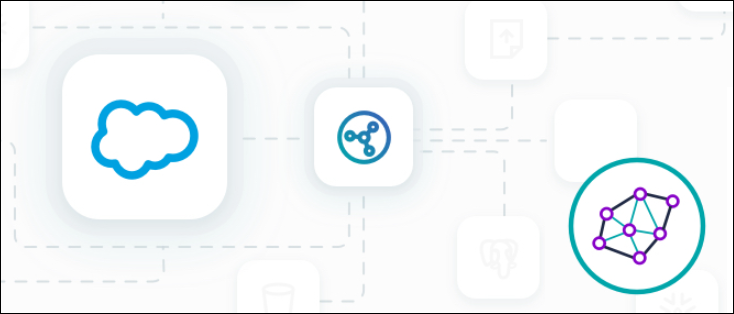
With data mapping, we allow the creation of both Customer Data Tables (CDTs) and User Defined Tables (UDTs), which means your data source can be used in conjunction with our upcoming major feature, Apteco CDP.
Note: In the first iteration of Salesforce as a data source, we’re not including preconfigured dashboards or specialised support.
For more information on Salesforce as a data source with Apteco, see:
-
Technical documentation: How to set up and configure salesforce as a data source
-
User documentation: How to use salesforce as a data source
Complete Salesforce integration
Combined with our June 5th release of Salesforce channels in Orbit campaigning, Apteco now offers an end-to-end Salesforce integration. You can import your Salesforce data, apply flexible field mapping in the channel editor, and then use Orbit campaign journeys to upload audience data back to your Salesforce system.
For more details on using Salesforce in Orbit campaigns, see Salesforce Sales Cloud.
New features and improvements
Campaign
Campaign calendar
The new campaign calendar gives you complete visibility of your scheduled marketing communications.
The calendar acts as a workflow that displays the next scheduled run for each campaign stage:
-
Single-stage campaigns show when they will next run, updating automatically after each execution
-
Multi-stage campaigns show the next stage due to run, whether that's the initial stage or a subsequent stage like a wait period
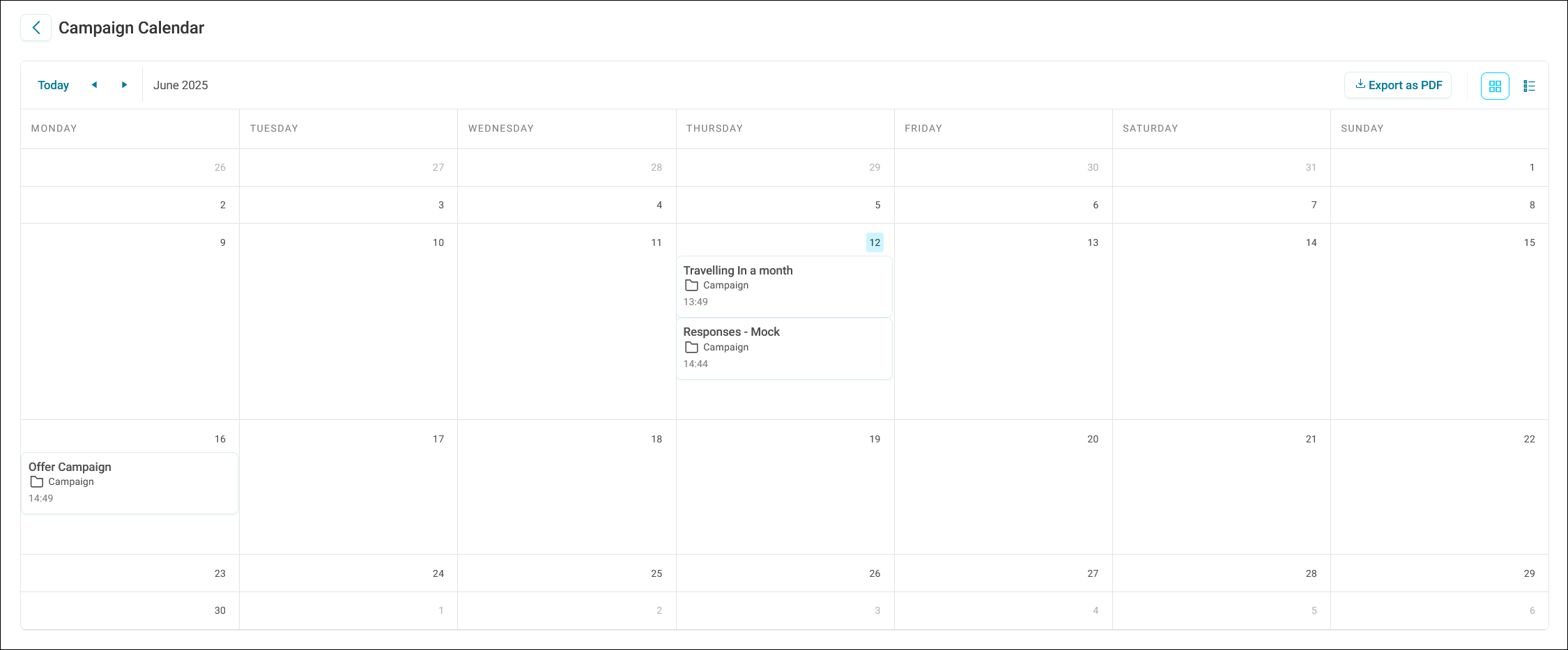
With your campaign calendar, you can:
-
Review the volume, topics, and timing of planned messages
-
Quickly spot gaps in your marketing schedule
-
Export calendar views to PDF
The ability to see all planned campaigns in a monthly or list view helps you make informed decisions about your contact strategy.
For more detail, see Campaign calendar.
Enhanced audience count breakdown
You can now see a more detailed explanation for audience volume drops in your campaign journey counts. The enhanced breakdown shows exactly which segments cause deduplication and by how much, along with splitting out segment limits and volume constraints.
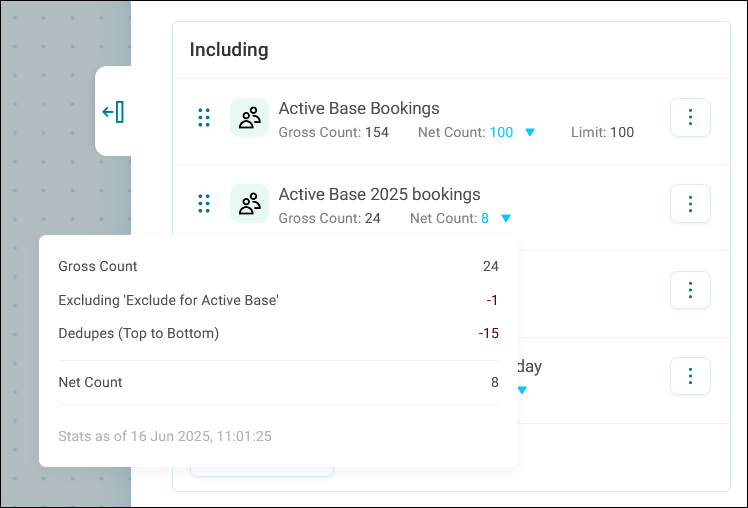
For more detail, see Audience counts.
Dashboards
Switchable axis labels
You can now choose whether to display (or not) axis labels on tables, cubes, and charts. This feature is applied using toggle switches for each respective row, column, and measure title in tables and cubes, and is turned off by default for cubes and tables, and on by default for charts.
New map tile using dashboard theme for default colour scale
New dashboard map tiles now use the dashboard theme you've selected to generate the default colour scale. This means that when you add a map tile and change your dashboard theme, this is reflected in the map 'high colour', with the ‘low colour’ remaining white.
Multi-dimension tables and cubes in dashboards
With an Analyser licence, you can now add multiple dimensions to tables and cubes in audiences and dashboards. This improvement greatly expands the depth of analysis available to Analyser licence holders.
Business date banding can be used for dimensions
You can now use business date banding for dimensions. When you have business date setting configured in your FastStats system, and create a cube or chart in Orbit with a date variable, these bandings now appear on your visualisation, if selected.
General
Deep routing in Orbit redirects to browser locale
Deep routing in Orbit without a set locale now applies the locale of your default browser by default. This means, for example, if you’re located in Germany but have not set your locale, then Orbit detects your default browser locale and applies this to any redirects outwards from Orbit.
Bug fixes
Connect
-
Field enclosers are now detected when using tab delimited files, as expected.
Dashboards
-
Variables are no longer omitted from system lookup measure comparison value periods.
-
We've increased the size of the date dialog custom value numeric input, improving readability and usability.
Campaigns
-
The loading indicator now appears correctly when you access your campaigns list.
-
The campaign filter controls no longer remain active when viewing the Overview and Monitoring tabs.
05 June 2025
Version 2.1.28
Headline feature: Campaign folders
Transform how you organise your marketing activities using the new campaign folders to help keep your team organised and ensure everyone can find what they need quickly and effectively.
You can group related campaigns together, making it easier to manage seasonal campaigns, product launches, or departmental initiatives. The new ability to move and copy campaigns between folders allows you to adapt quickly to organisational changes. Any search or filter applied includes both folders and campaigns in the results, giving you a full view of your campaign structure.

Campaign folders provide a hierarchical organisation system that helps you:
-
Create intuitive folder structures that mirror your marketing strategy
-
Easily navigate with the new breadcrumb trail interface
-
Search and filter campaigns across your entire folder structure
-
Create nested folders to any depth for complex hierarchies
-
Rename folders while keeping campaigns in place and preserving all campaign history
-
View comprehensive monitoring data at any folder level
-
Duplicate campaigns within the current folder
-
Move draft campaigns to another folder where you have Create Rights permissions
-
Copy campaigns (in any state) to another folder where you have Create Rights permissions
Note: Folders in Orbit are fully cross-compatible with PeopleStage. Folders created in Orbit appear as areas in PeopleStage, while Areas created in PeopleStage appear as folders in Orbit.
Note: The delete functionality for campaign folders requires Apteco software version Q2 2025.
For detailed documentation, see Campaign folders.
New features and improvements
Campaigns
Quick messages: Send one-off campaigns fast
Quick messages are a new campaign type that helps you send one-time communications to external contact lists without using your main customer database.
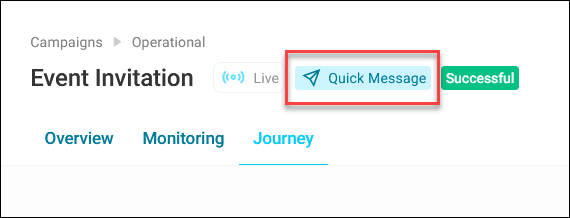
Quick messages let you upload a CSV, TXT, or TSV file of email addresses or mobile numbers. You can then send an immediate email or SMS campaign to these contacts. This feature provides a simple ad-hoc approach for prospects or contacts from external data feeds who aren't in your Apteco system.
Use quick messages to send urgent webinar invitations to networking contacts, communicate with trade show leads, or run campaigns to prospect lists whilst keeping them separate from your main system data.
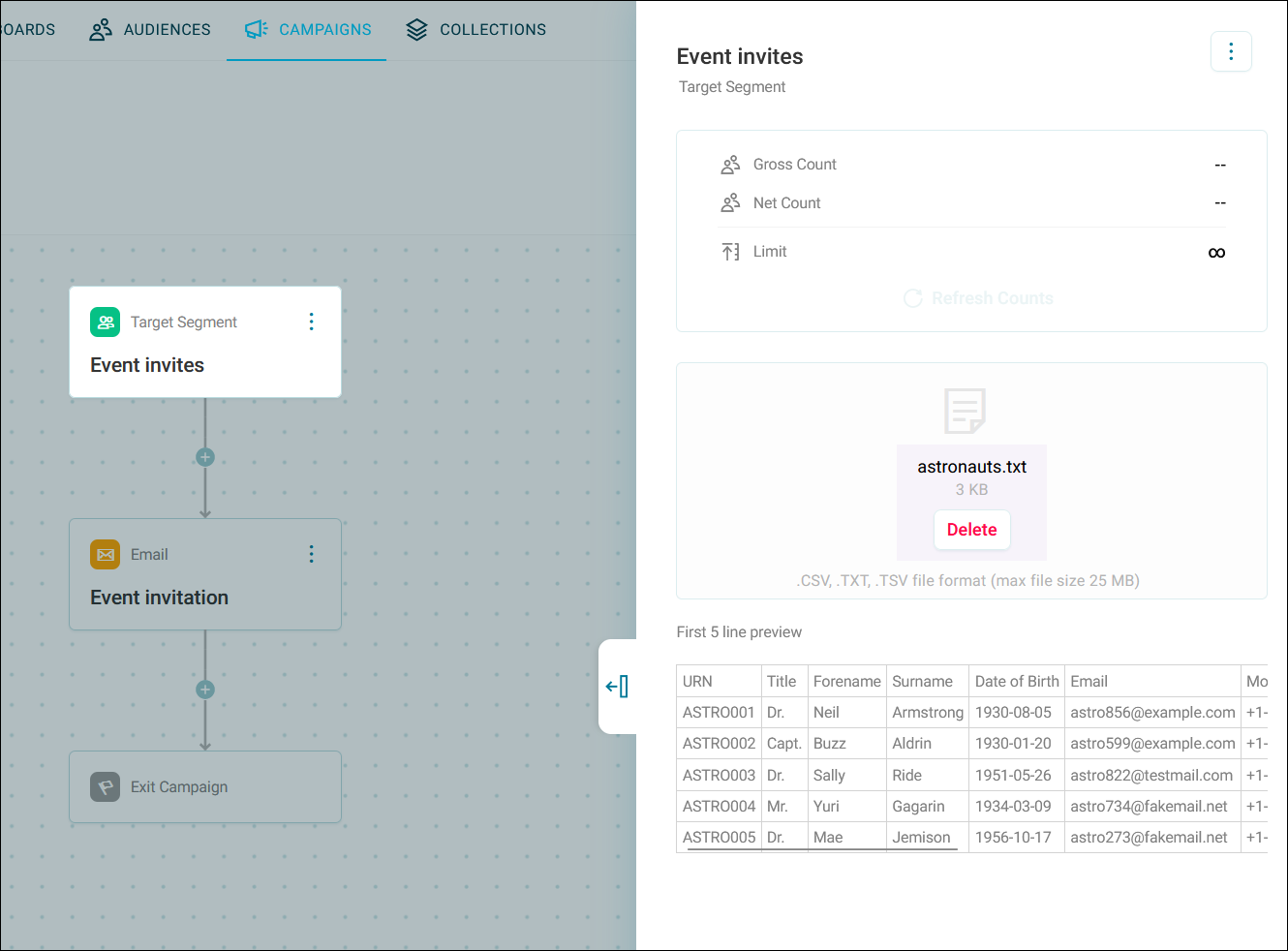
Key benefits:
-
Send campaigns to external lists without importing contacts into your Apteco system
-
Upload CSV, text, or TSV files directly into your campaign
-
Record basic communication history for auditing purposes
-
Access the same personalisation and template features as standard campaigns
Quick messages work differently from standard campaigns. As one-off campaigns, they do not include interaction splits or complex audience logic. You also can't schedule campaigns for future delivery.
For detailed documentation, see Quick messages.
Note: This feature requires Apteco software version Q2 2025.
Note: This feature is for Apteco email users.
Google Analytics reporting integration
You can now benefit from Google Analytics reporting in Orbit, giving you direct access to campaign performance data within your campaign overviews.
Connect your Google Analytics account to Orbit and monitor web page activity from your campaigns using UTM codes. This integration brings essential campaign performance metrics directly into the campaign overview tab, eliminating the need to switch between platforms to assess your campaign impact.
The feature supports comprehensive tracking through UTM parameters, allowing you to monitor user behaviour, engagement, and conversion data for campaigns that drive traffic to your website. You can track one data stream (website) per campaign and access key performance indicators alongside your existing campaign metrics.
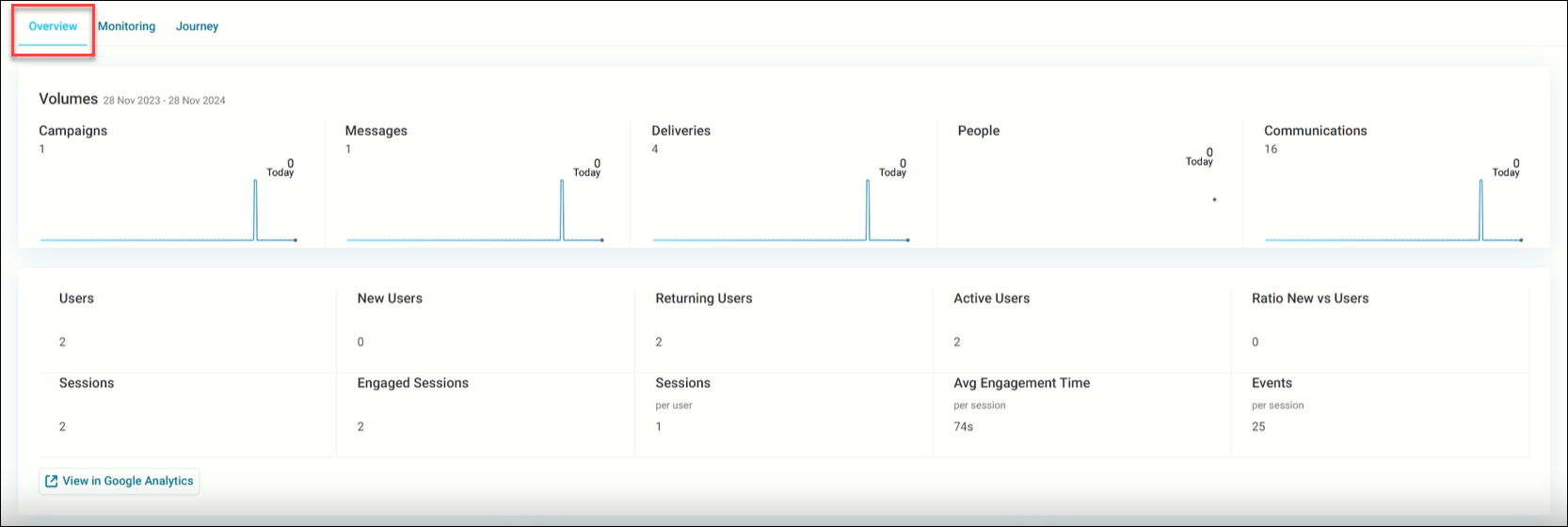
Key benefits:
-
View campaign performance and web analytics data in one location without switching platforms
-
Monitor campaign impact on website traffic and user engagement immediately
-
Access comprehensive data to compare campaigns and optimise future strategies
Many key metrics are available to view in your campaign overview, like New Users, Active Users, Average Engagement Time, etc. For deeper analysis, you can click View in Google Analytics to access detailed reports, traffic source breakdowns, and advanced user behaviour insights directly in your Google Analytics account.
For a full list of available metrics and supporting documentation, see Google Analytics reporting.
Campaign structure personalisation field
You can now add a campaign structure personalisation field to your communications and output files in any campaign message. Use this to insert the campaign name or message name directly into your content.
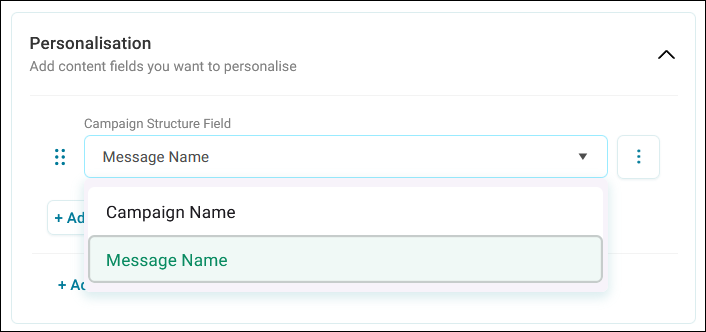
Key benefits:
-
Track which messages recipients received without manual input
-
Include campaign data in CRM system uploads
-
Maintain audit records
For more detail, see Campaign structure content field.
New CRM channel integrations: Salesforce and Microsoft Dynamics
You can now set up Salesforce and Microsoft Dynamics channels directly in the Orbit channel editor, eliminating the need to create these channels in PeopleStage.
Add these channels as campaign journey steps to upload data directly to your CRM systems. Both channels offer flexible field mapping capabilities.
Key benefits:
-
Configure channels directly in Orbit
-
Customise field mappings to match your data requirements
-
Add CRM upload steps within campaign journeys
What's next: In a future release, you'll be able to add both Salesforce and Microsoft Dynamics as data sources through Orbit connect. This will allow you to bring data from these platforms into your Orbit system to use in your campaign journeys.
Note: This feature requires Apteco software version Q2 2025.
For more detail, see:
Connect
Apteco CDP: Store primary address columns
A 'Primary Address' is now included for contacts in the Apteco CDP.
Note: Apteco CDP is still in preview. For more information on this and our other preview features, see our insider programme page.
This update affects the diagrams documented in Customer Data Table and Reference CDP data structures.
Enhanced system definition navigation
We've introduced simpler navigation for system navigation with connect. You can now use a grab action to move your diagram and there's an improved zoom control to either look at sections in more detail or view your diagram as a whole.

General
We now display consistent formatting options across all areas of Orbit, in alignment with Orbit design standardisation principles.
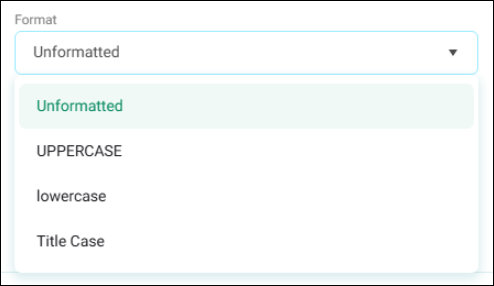
This update applies to:
-
Dashboards: Editing a data grid tile, on a text/selector variable column, find 'Formatting'
-
Audiences: On a datagrid/export item, click 'Edit Columns', click on a text/selector column, find 'Formatting'
-
Campaigns: Editing a journey, on an Email Step, under 'Personalisation', add a variable content field, choose a text variable, and click action menu > Formatting
-
The channel editor: Click on a channel, choose additional variables, add a variable, check 'Formatting'
Bug fixes
Dashboards
-
We've fixed a bug causing pie chart visualisations to appear extra small with elevated dashboards.
-
Data grid preview now updates correctly when you change the formatting on a column.
-
You can now reset quick search filter entries on a dashboard tile, as expected.
-
Map tile background colours now apply successfully, as expected.
-
Dashboard Technology Elevation (DTE) no longer causes 'DataBlock' error messages.
-
A 'TypeError' no longer appears when you drilldown on a data grid tile.
-
'Drilling up' on a dashboard chart no longer prevents all other pre-existing chart drilldowns on that dashboard from working.
-
Data grid hyperlinks are now available in page view.
Audiences
-
When viewing an audience map in read-only mode, a 'Stay and save' information pop up message no longer appears.
Campaigns
-
Campaign tracking dashboards in Orbit now use the currency specified in the PeopleStage diagram settings, not GBP (£) by default.
General
-
Resetting your password on a non-defined data view no longer reveals the name of your dataview system.
-
When creating a map definition, you can now use flag arrays as geographical variables, as expected.
21 May 2025
Version 2.1.27
Headline feature: Data grid hyperlinks
This dynamic new feature allows you to transform content within dashboard and audience data grid cells into functional hyperlinks, extending the analysis capabilities of your data even further.
Once your system administrator has set up the appropriate variable(s) and securely defined the URLs via application settings, you can click URLs within a data grid and navigate directly to external systems.
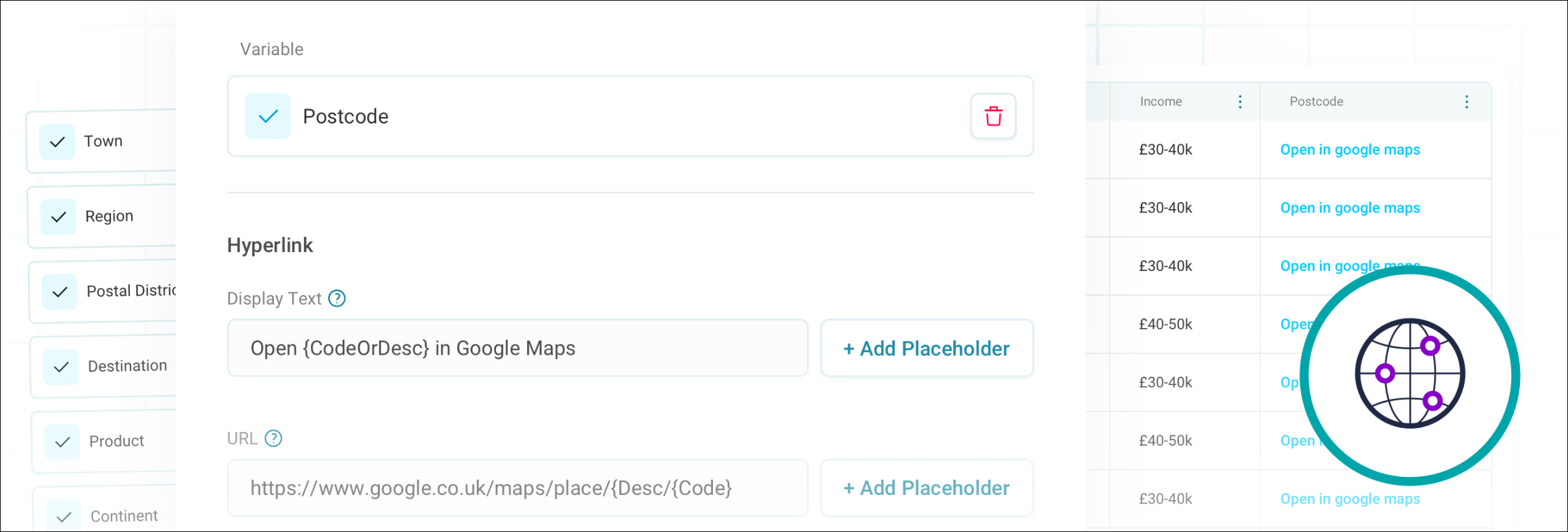
Data grid hyperlinks in dashboards and audiences open your target in a new browser tab. These hyperlinks also remain functional when the dashboard or audience is exported to PDF, or shared with another user on the same system.
This improvement makes your shared dashboard and audience data grids more interactive, so you can seamlessly continue your analysis experience at the click of a link.
For more detail, see Data grid hyperlinks.
New features and improvements
Campaigns
Track campaign goals using date-based criteria
You can use date variables when defining goals in Orbit campaigns, giving you precise control over your campaign goal tracking periods.
Using a date variable to track the achievement timeframe criteria ensures only relevant actions are counted towards your goals by specifying when actions should occur, counting only activities that happen after a customer enters your campaign and within your defined date range.
How it works:
-
Apply a date variable to set the tracking period for your goal
-
Orbit tracks qualifying transactions from the first communication until your specified end date
-
View results in the campaign-linked dashboard showing how many recipients meet the goal
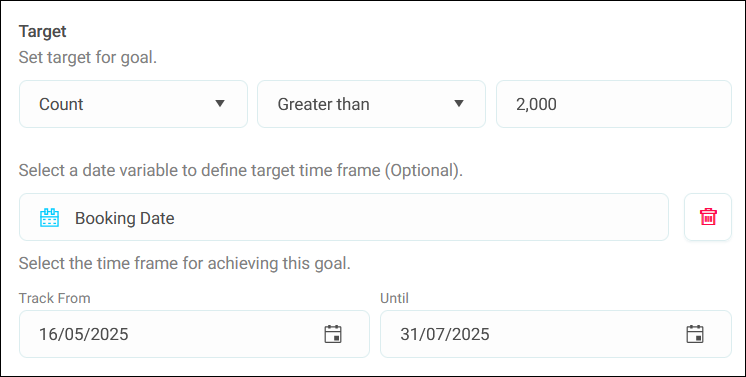
Key benefits:
-
Accurate measurement of campaign effectiveness by counting only new behaviours
-
Clear insight into the direct impact of your communications
-
Ability to focus on specific time periods relevant to your campaign
For more detail, see Campaign goals.
Apteco email reporting and CSV export
Apteco email users can now benefit from an enhanced Campaign overview screen with comprehensive real-time email campaign performance metrics. This update provides immediate visibility into engagement data and email interaction statuses directly within your campaigns.
Key benefits:
-
Immediate visibility into delivery and engagement metrics
-
Quick issue identification for faster problem resolution
-
Data-driven decision making to improve future campaigns
-
Reputation management through spam monitoring
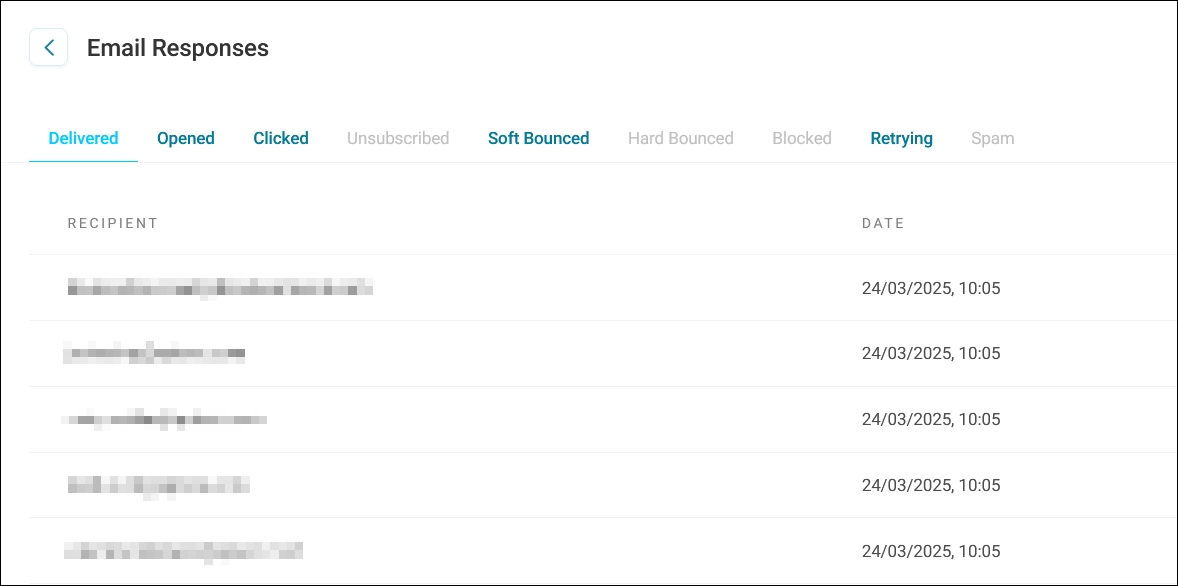
Email interaction metrics:
The new reporting interface displays key email performance data through specialised sections:
-
Delivery tracking - Monitor successful deliveries with timestamps
-
Engagement metrics - View opens and clicks with precise timing
-
Bounce management - Identify both hard and soft bounces
-
Spam monitoring - Track recipient spam reports
You can search across all response types and export comprehensive CSV reports for further analysis or sharing with stakeholders.
Note: This feature requires Apteco software version Q2 2025.
For more detail, see Apteco email reporting.
Build expressions for message personalisation
You can now create dynamic, personalised messages directly in Orbit without pre-saving expressions in FastStats. This powerful feature helps you deliver highly relevant content based on customer data, improving engagement and response rates.
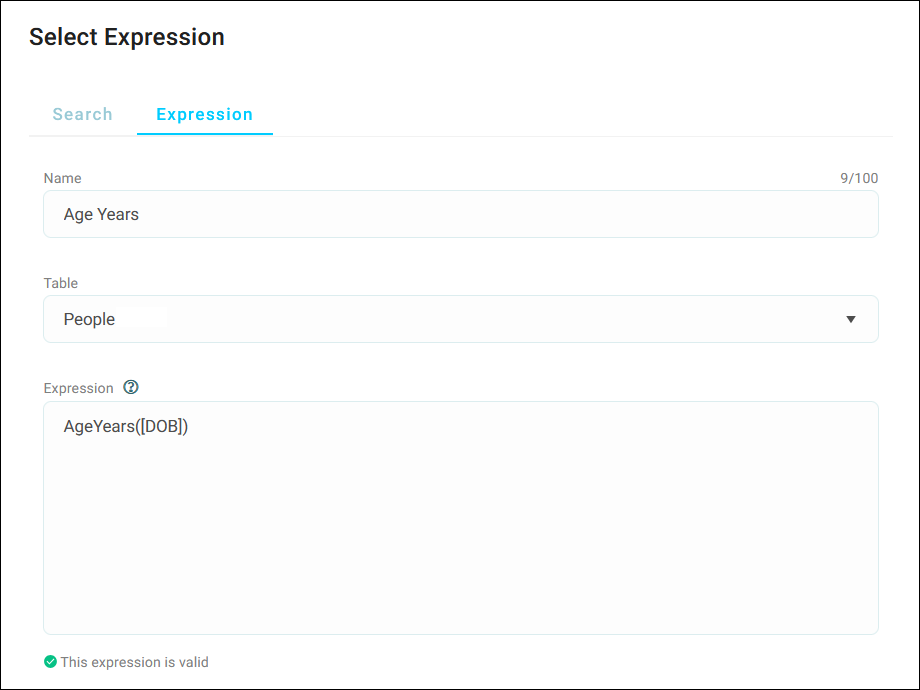
Key benefits:
-
Create personalised content based on customer attributes and behaviour
-
Tailor offers and discount levels according to purchase history
-
Implement conditional content using 'IF' statements
The expression builder supports date, text, and numeric outputs, giving you flexible options for personalising your campaigns. You can use any variables available in your FastStats system to create dynamic content that resonates with each recipient.
Note: Available with the Analyser bundle and above.
Note: Recommended for experienced FastStats users or system administrators.
Note: External data sources and system variables not currently supported. Drive time calculations not available.
Note: This feature requires Apteco software version Q2 2025.
For more detail, see Building expressions for message personalisation.
UTM code support for Apteco SMS messages
You can now automatically add UTM codes to links in Apteco SMS messages. Simply use the toggle in your SMS message side panel so Orbit can automatically apply UTM codes to any link.
![]()
Adding UTM codes lets you track link clicks in tools like Google Analytics. You can see which SMS messages drive traffic and measure campaign performance more accurately.
Available UTM values:
-
utm_campaign: Orbit campaign name
-
utm_medium: Set to SMS
-
utm_source: Orbit message name
Note: This feature requires Apteco software version Q2 2025.
For more detail, see UTM code tracking.
Hashed email support for social ad channels
You can now use hashed email addresses when setting up Social channels in the Orbit channel editor.
When configuring your channel, choose a variable that contains hashed emails or mobile numbers (for Facebook only). If your data doesn't include hashed emails, you can let Apteco hash the email addresses during the delivery or upload stage.
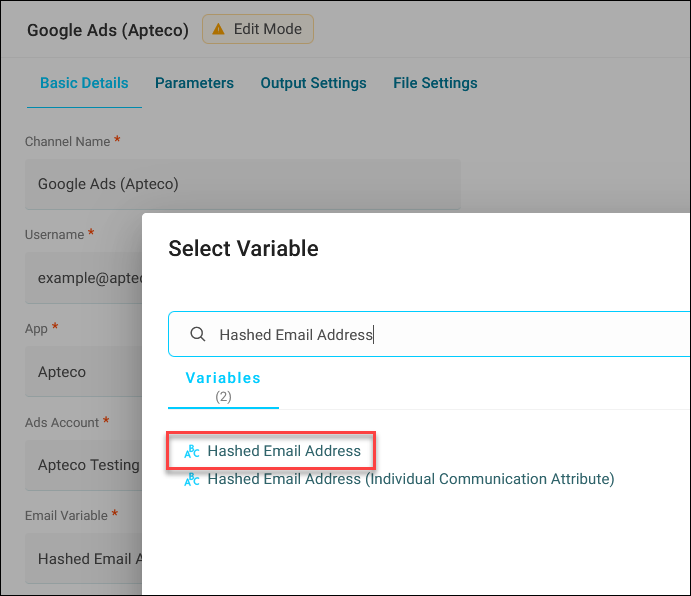
Key benefits:
-
Supports CRM systems that store only hashed contact data
-
Adds security when moving and using contact data
-
Matches contacts securely on platforms like Google Ads, Facebook Ads, LinkedIn Ads, and X Ads
This gives you more control over how contact data is matched in custom audience uploads for social ads.
Note: This feature requires Apteco software version Q2 2025.
Campaign overview responses update
We've improved how channel statistics display in the campaign overview screen to provide clearer visibility of your marketing performance.
Email and SMS statistics now display separately in the Responses chart, with email showing first. Headers now clearly indicate which channel stats you're viewing.
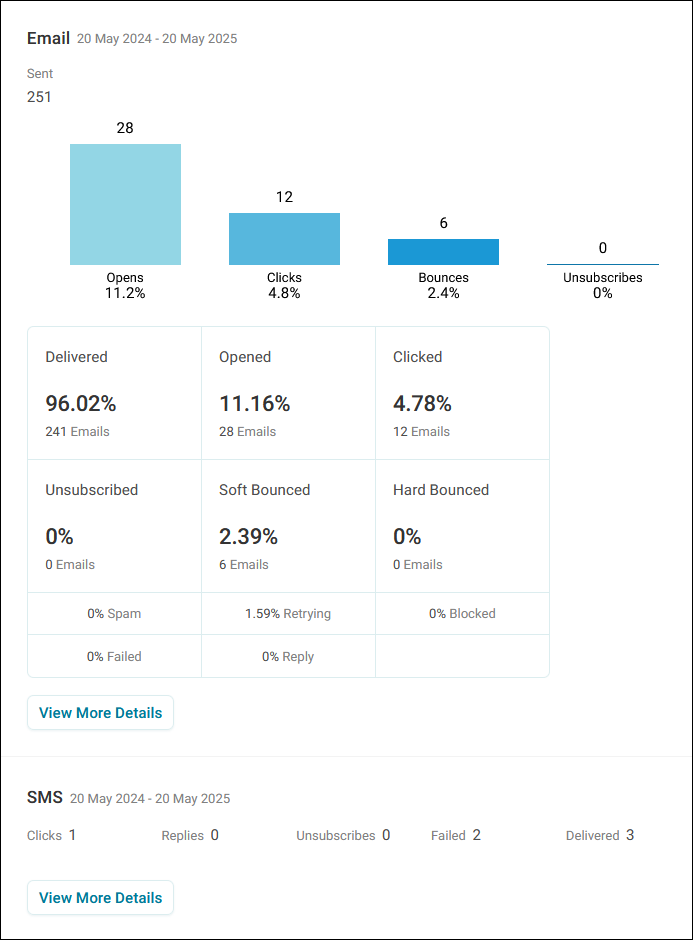
We've also added responses support for these social channels:
-
Google
-
WhatsApp
-
LinkedIn
For campaigns using multiple email providers, Apteco email displays as the primary channel with alternative provider metrics shown below.
Note: Apteco email users can click View More Details to see and export more comprehensive metrics.
Note: This feature requires Apteco software version Q2 2025.
For more detail, see Overview tab.
Clearer Reply field for Apteco email and SMS
We’ve removed the unused Reply email address and Reply mobile number fields from the Basic Details tab for Apteco email and Apteco SMS. You can find the correct Reply field on the Parameters tab in the channel editor.
For more detail, see Configuring your Apteco email channel.
Improved campaign delete handling
When deleting a campaign, Orbit now displays a loading animation in place of the option menu. This provides visual feedback during deletion and prevents multiple delete attempts that could trigger error messages.
Default UTF8 encoding for Apteco email
We've updated all Apteco email channels to use UTF-8 encoding by default, improving your ability to consistently send emails with international characters and special symbols.
Google Analytics configuration update
To show Google Analytics reports on the Campaigns overview screen, the system administrator must now update the Orbit API configurator. Add the Analytics Account Property ID under the GoogleAnalytics service tab to enable reporting.
Bug fixes
Connect
-
An Apteco connect system built in a time zone other than UTC no longer displays an incorrect build time pop up when deployed.
Dashboards
-
Zooming or panning on a map no longer incorrectly resets your selection.
-
Cubes and tables with multiple measures now only display a representative subset of data points for better visibility.
-
Displayed percentages in one dimensional bar and column charts now show absolute counts when you mouseover them, as expected.
-
Dashboard maps now export to PDF successfully and render correctly.
-
You'll no longer experience issues when opening a dashboard with a map, when the corresponding geographical virtual variable used in the map definition doesn't exist.
-
Maps no longer have blank segments when variable descriptions don't exactly match the casing of feature descriptions.
-
Maps now exhibit more reliable zoom and position behaviour when editing a dashboard tile.
-
We’ve disabled the display zeros option for pie, donut, and funnel charts.
Audiences
-
You can no longer create an audience from a selection without the required ability/permission to create an audience.
08 May 2025
Version 2.1.26
New features and improvements
Campaign
Improved layout for message objective configuration
In Orbit campaigns, the message step side panel now shows the Response Time Window settings first for message objectives.
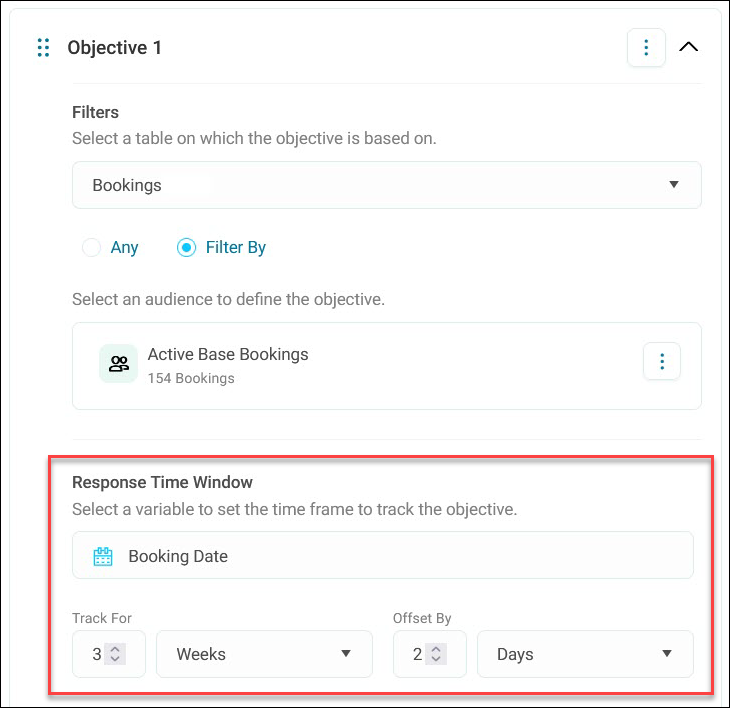
This change ensures that required fields, like Response time window, appear before optional fields. It also improves usability by placing the Filter and Response Time Window settings closer together.
For more detail, see Message objectives.
Enhanced Google permissions transparency
We've improved visibility into Google permissions with a new detailed permissions dialog. This enhancement makes it easier to understand exactly what access has been granted to Google services within Orbit.
The new permissions dialog shows:
-
Detailed description of app scopes granted by each user/email
-
Complete list of Google Ads and Google Analytics accounts the user has permission to access
You’ll find this in Account Settings by clicking View Permissions next to the account email.
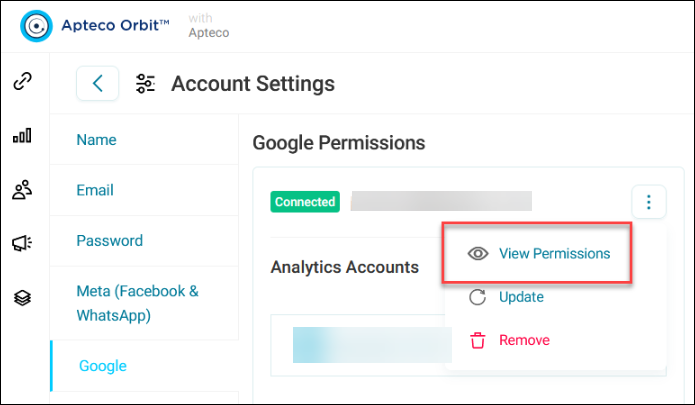
This enhancement has several benefits:
-
The interface clearly displays all granted Google permissions, improving transparency and simplifying account management for administrators
-
Better security oversight allows verification of appropriate permission levels for all connected Google Ads and Google Analytics accounts
-
Quick identification of permission-related issues streamlines troubleshooting when working with Google services
Dashboards
Option to hide filters from dashboard viewer
This new Orbit Dashboards feature provides dashboard editors with the option to selectively hide dashboard filters and the quick search filter on a per-dashboard basis.
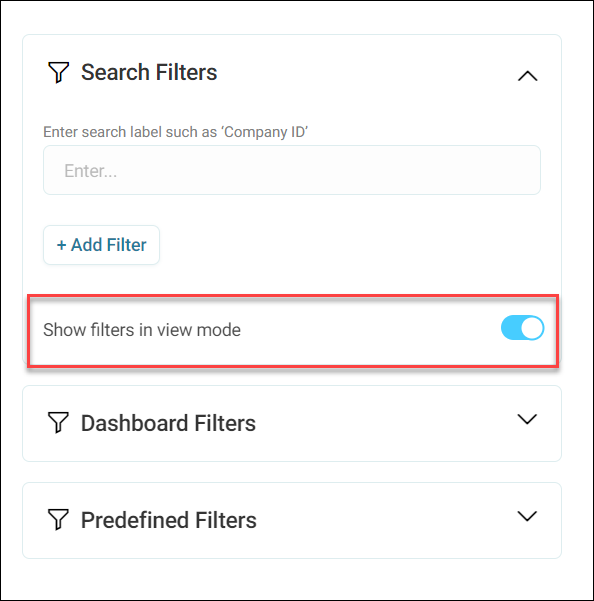
Key functionality:
-
Granular control: Editors can choose to hide filters for each individual dashboard
-
Flexibility: Options to hide both standard dashboard filters and the quick search filter
-
User-specific: The visibility settings only affect dashboard users, not editors
-
Easy toggle: Simple on/off controls in the dashboard editor interface
-
Improved focus: Ability to create cleaner, more focused dashboards when filters aren't needed
Benefits:
-
Enhances the customisation options for dashboard creators, allowing them to tailor the user experience based on the specific needs and audience of each dashboard.
-
By hiding filters when they're not necessary, editors can create more streamlined and intuitive dashboards for their users.
Use designer specified sort order for selector categories
We now use the specified sort order from Designer for selector categories. This means you can now select the 'Previous code sort' option via the action menu.
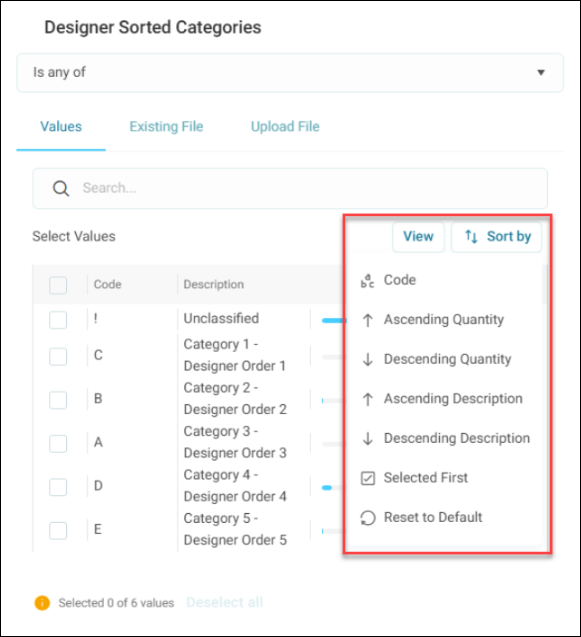
Bug Fixes
Dashboards
-
Dashboard tiles now more effectively manage displaying (or not displaying) unclassified categories on date variables with multiple zero values.
-
For number cards, we’ve now removed the 'Display As' percentage option for currency variables.
-
Dashboards can now successfully add XML FastStats selections as a Venn filter.
-
On dashboard data grid tiles, setting 'Show unclassifieds' as blank now works as expected.
-
We've fixed an issue preventing you from selecting rows on a newly created datagrid.
-
Filtering a dashboard tile so that it has no results, no longer generates a 'No data to display' message when you’ve chosen to display zero values (or when this option is not available).
-
Measures and calculated measures are now correctly translated for different locales, as expected.
-
Cached map settings are now successfully applied across multiple Orbit DataViews/databases.
-
Number cards are now successfully exported to PDF without clipped displays.
-
The dashboard 'Save' option is now enabled in all applicable create and edit states, as expected.
-
Dashboards exported to PDF no longer incorrectly invert cube vertical dimension labels.
-
Earliest’ and ‘Latest’ dynamic dates can now be used successfully with fixed dates. This fix also applies to ’Earliest’ and ‘Fixed’ dynamic dates.
28 April 2025
Version 2.1.25
New features and improvements
General
Swap sides button relocation
We've relocated the side panel 'Swap sides' button. Previously, this button was located at the top left of your side panel menu by default. However, this could be mistaken for a close button. It's now more intuitively placed midway down the side panel, with an updated icon more accurately representative of the swap sides action.
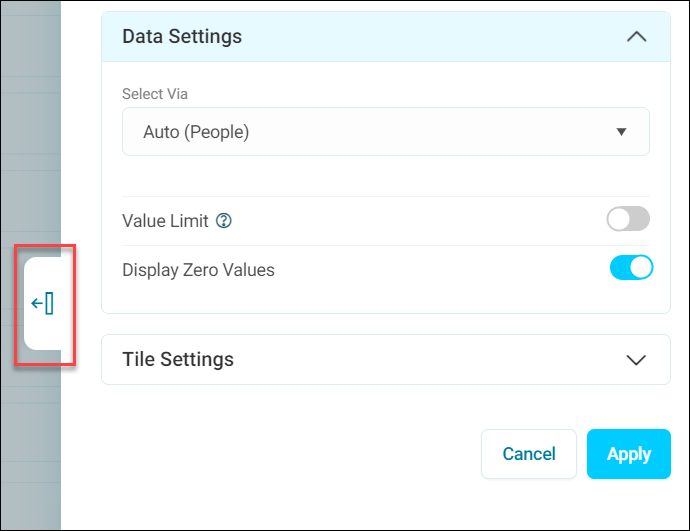
Dashboards
Improved dashboard filter reset functionality
We’ve improved how the dashboard filter reset button functions. When you add a user filter, a ‘Reset all’ button now becomes visible alongside the ‘Filters’ button. If you press the ‘Reset all’ button, your user filters are removed and the button disappears.
Note: We are aware this button does not currently check you are sure, so use it with care!
Orbit sort order selector categories
Orbit now displays selector categories in the order defined in the FastStats Designer data build process, rather than always alphabetically as before.
Earliest and latest options now available for date rules
We've added ‘The Earliest Date’ and ‘The Latest Date’ options for the ‘Start’ and ‘End’ choices of dynamic date ranges when using the ‘Start and End’ option. These options refer to the current extent of the date or date time variable you are using.
Campaigns
Google Admin UI update
We’ve updated the design of the Google Ads Admin UI to match the layout and style used in other social platforms. This improves consistency and helps you work more easily across different social integrations.
Bug Fixes
Dashboards
-
You can no longer incorrectly add another pareto to a dashboard that already has one. When you try to add a second pareto to a dashboard, you now receive an error message stating that one is already present.
-
You can now only successfully duplicate a dashboard when you have the Analyser or Predictor bundle.
-
Creating an Orbit user without adding an associated email address no longer generates an error message.
-
Date preview is now correctly displayed with custom date rules.
-
We've fixed an issue preventing FastStats selections from working correctly on tile filters.
-
We've improved performance on charts with very large numbers of categories and solved an intermittent issue causing a 'Maximum call stack size exceeded' error message.
-
The dashboard 'Display Zero Values' option is now visible and selectable on a Table tile, as expected.
Known issue: We’ve identified a virtual variable issue affecting Cube and Table tiles. A virtual variable defined by an expression referencing 'Today(0)', and used on a Cube or Table tile, displays multiple rows which are incorrectly generated, rather than a single row with today’s date as expected.
Workaround: As a workaround, we currently suggest that you turn off ‘Display Zero Values’ on your affected Cube or Table tile. We’re working hard on a solution to this issue and will make it available as soon as we can. We appreciate your patience in this matter.
Connect
-
We've found and fixed an issue that caused testing any of URLs specified within the Orbit Updater configuration to always fail on the third attempt.
Campaigns
-
We’ve found and fixed an issue where accessing the Apteco email image gallery redirected you to the email templates list instead of opening the gallery. This also fixes an issue where pressing image on a template, form, or landing page did not show options to replace or edit the image.
17 April 2025
Version 2.1.24 (Out-of-band release)
With Orbit version 2.1.23 on Monday 14th April, we released a major update to existing Orbit dashboard functionality - dashboard technology elevation. This was a wide ranging update applied to all existing Orbit dashboard functionality.
To further supplement this update, we’re releasing the following patch fixes to address a number of issues encountered when migrating from old to new dashboard technology.
Note: If you have auto-update turned on for Orbit, then the patch will update automatically. If not, please refer to the software releases page on the Apteco portal to download the latest version of Orbit.
Patch fixes
Dashboards
-
Older dashboard definitions with currency variables are now successfully brought through with dashboard migration.
-
Two dimensional charts with large cardinality no longer cause performance issues when using tile filters.
-
A theme applied to a dashboard is now successfully represented in all it's associated pie charts.
-
When you change a dashboard theme, it's now represented accurately in real-time by any associated dashboard visualisations.
-
You can now view a dashboard successfully even if an associated variable is invalid or has not refreshed.
-
On a single dimension chart, when you set the ‘Display As’ to ‘Percentage of Series’ and then abbreviate the labels, you’re no longer prevented from viewing that visualisation.
-
If you edit a dashboard, then log out and discard your changes, an error message is no longer generated.
-
Dashboard number tiles are now displayed clearly and fully when exported to PDF.
-
Deleting a dashboard tile after you've made edits no longer generates a tileId error message.
-
When you edit and save a dashboard, unaffected tiles with long running jobs no longer recalculate unnecessarily.
-
Geo variable settings now load correctly on a dashboard map when you log out and back into Orbit.
-
Stacked chart legends no longer ignore any tile filters you've set.
14 April 2025
Version 2.1.23
Headline feature: Dashboard technology elevation
We’ve now introduced the new and improved edit panels from audiences to dashboards, making dashboard tile definitions clearer, faster, and more consistent.
This elevation of our dashboard technology simplifies training and onboarding of Orbit dashboard users, making what you learn in one area seamlessly apply to the other.
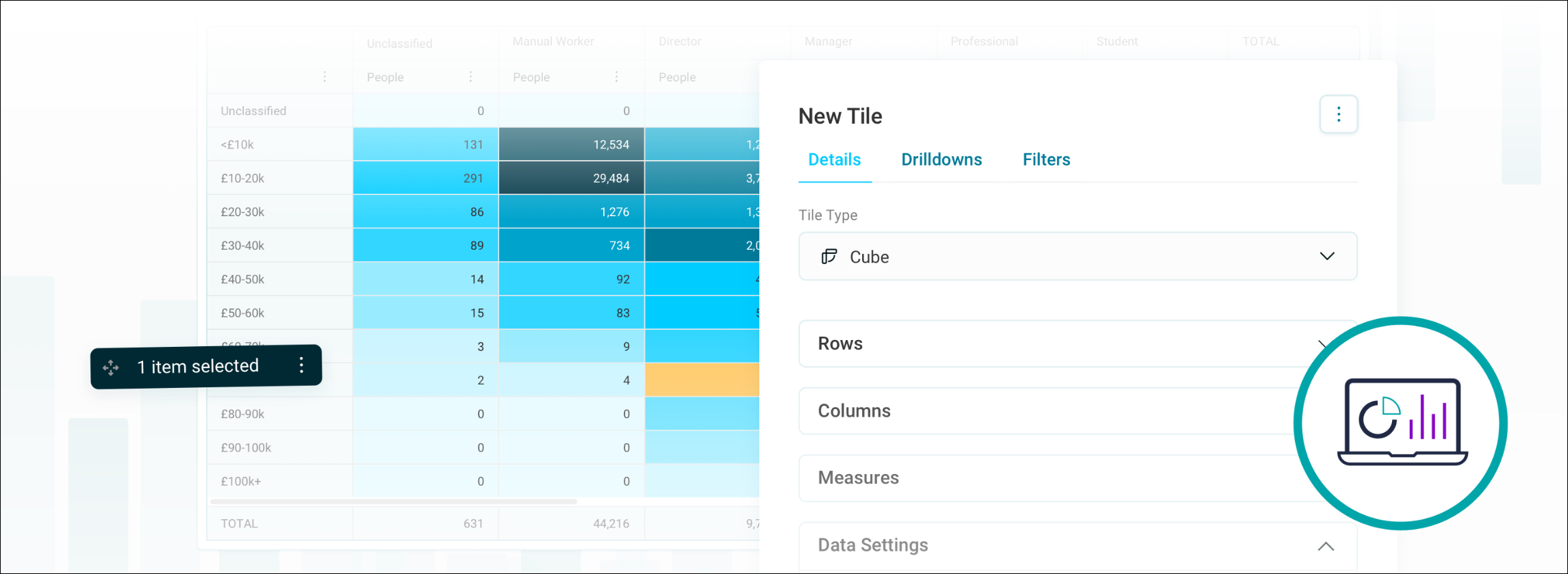
Tabs, tiles, visualisations, and filters remain unchanged, with the only visible difference being a more flexible filter selection menu, which is already in use for audience cubes, charts, and maps.
You can freely move the new floating selection menu to ensure that you have access to everything you select. This provides exactly the same options as the filter menu previously located in the top right of your tile.
Once you start using the new edit panels, you’ll unlock further powerful dashboard enhancements such as the ability to:
-
See the patterns more clearly with thematic colour scales on cube tiles, tables, and maps
-
Fit results to the tile space with more flexible, multiple category display limits
-
Focus on key results by displaying only the top or bottom values in an entire visualisation
We’ve improved your dashboard user experience considerably, by making several key information architecture enhancements.
The more logically organised structure and findability of UI elements significantly reduces cognitive load. This allows you to navigate and edit your dashboard more quickly and intuitively, using dashboards to effectively accomplish your goals.
Learnability is also improved, with consistent menu structures transferring across different areas of Orbit (between dashboards and audiences in this case), considerably improving onboarding and training knowledge acquisition rate.
Here are a few detailed examples illustrating elevated dashboard technology improvements:
Data grid editing
Editing a data grid now presents a well structured side panel menu. This side panel menu provides easily accessible detail, drill-down, and filter tabs.

Cube tile editing
Editing a cube tile now presents a similarly well organised and labelled interface, with rows and columns split to more easily navigate and interrogate your data.
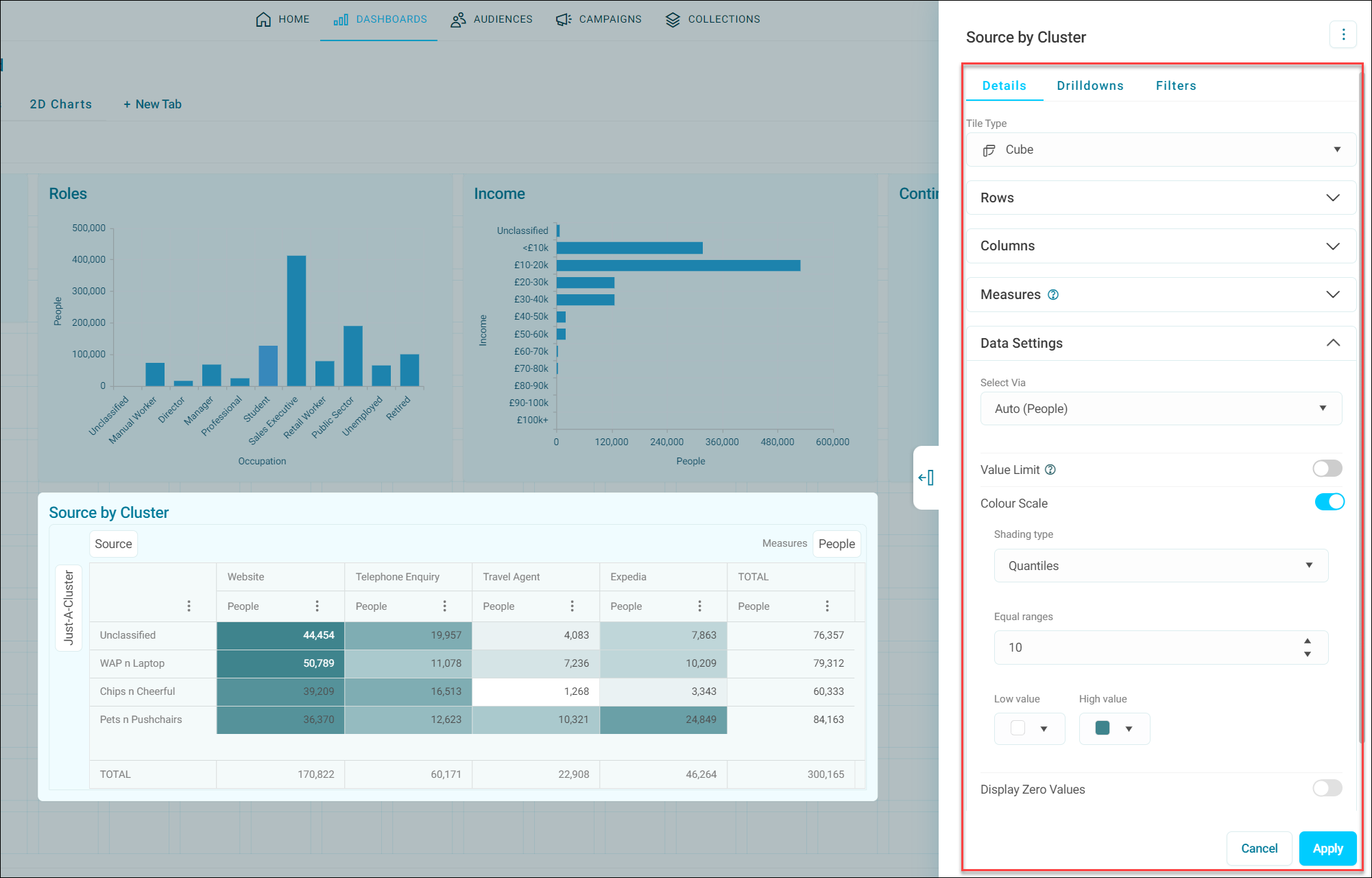
In addition:
-
Value limit: Can now be applied to your entire visualisation, if it’s cube based
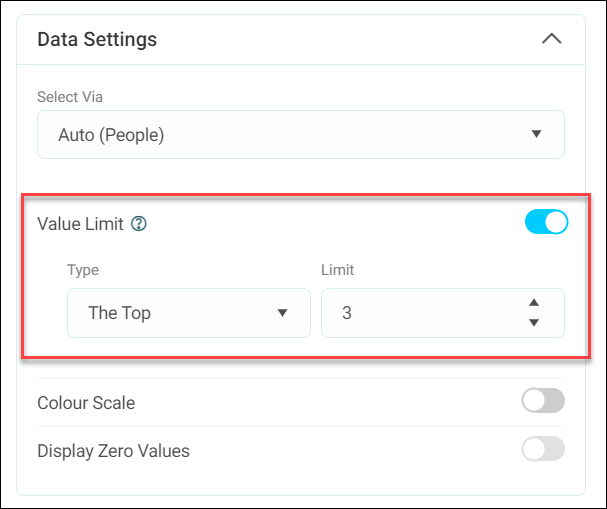
-
Category limit: Can now be applied to columns as well as rows
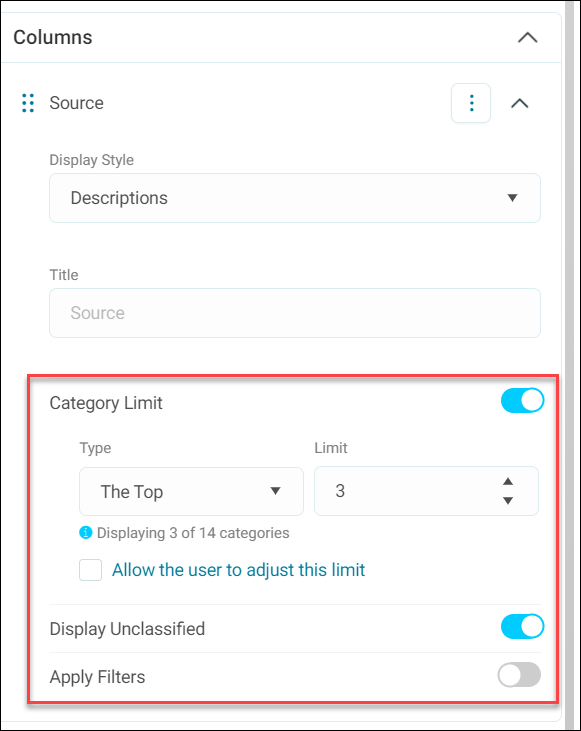
-
Colour scales: Can now be applied, allowing quantile shading in dashboard tiles
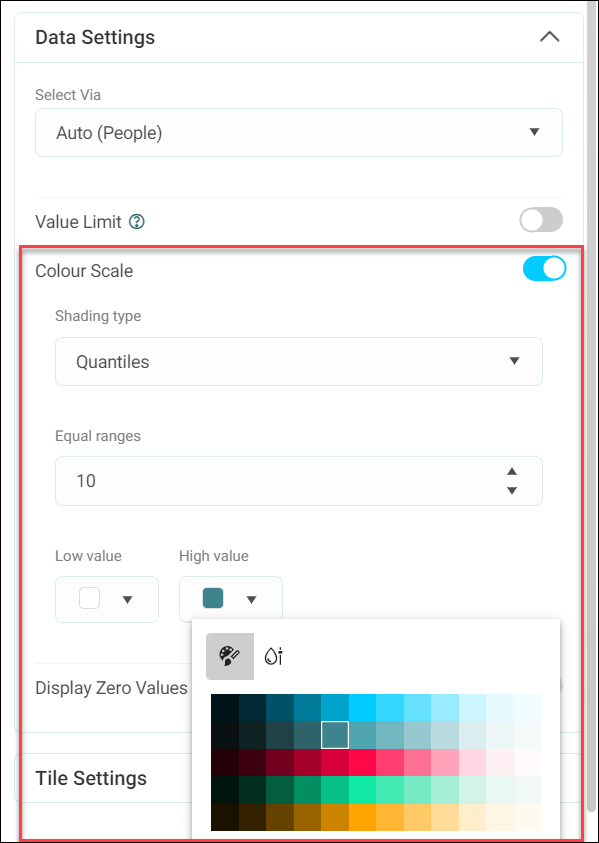
Map editing
We now have a single map type for user selection, for ease of use (with an administrator specified map definition via application settings), and quantile colour scale, for a more informative display.
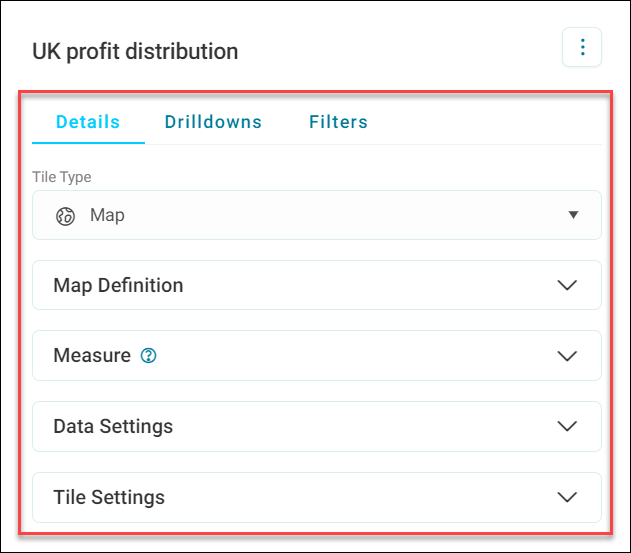
Here are some further examples of how dashboards now work with elevated dashboard technology:
-
Axis displays: There are now fewer ‘ticks’ (milestone numbers and names), displayed
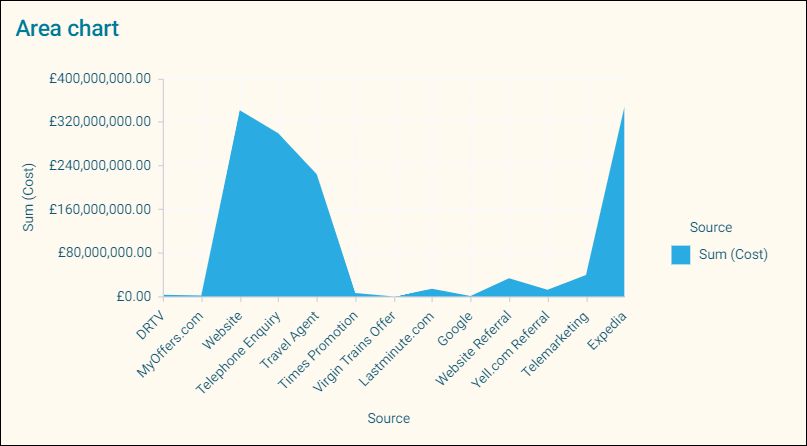
-
Map boundaries: Are cleaner and clearer, providing better visibility
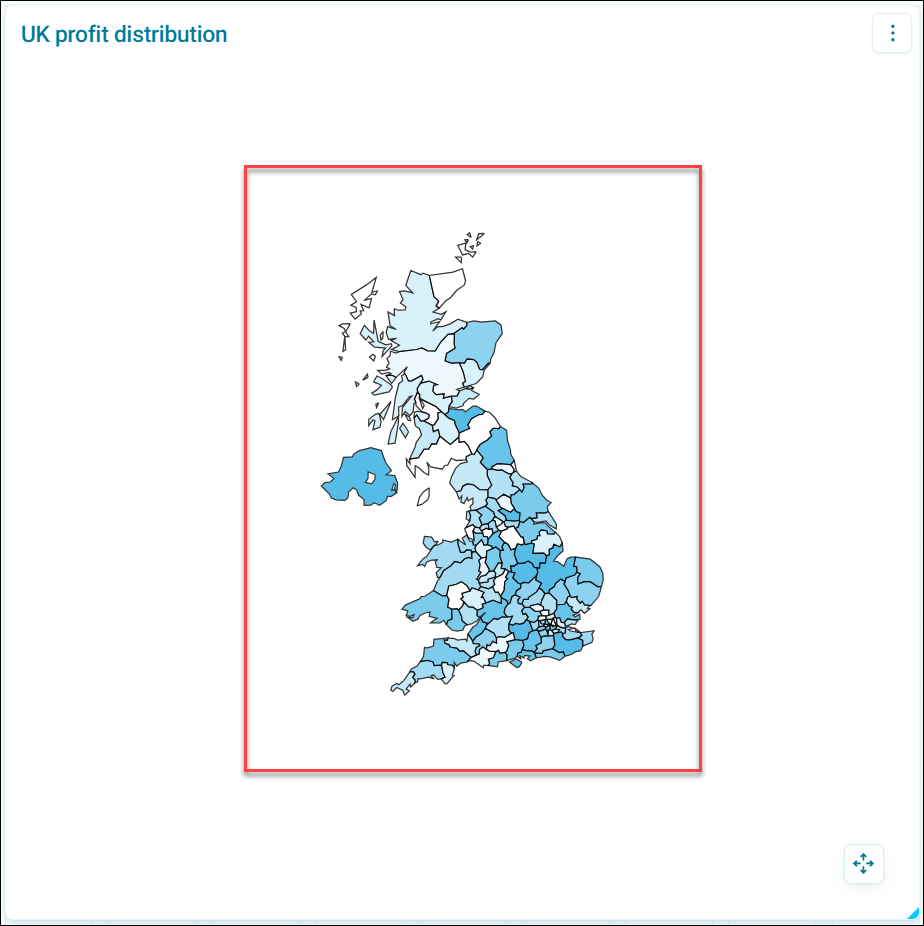
-
Selection menu: Is a moveable ‘pill’ option that you can use when multi selecting data points
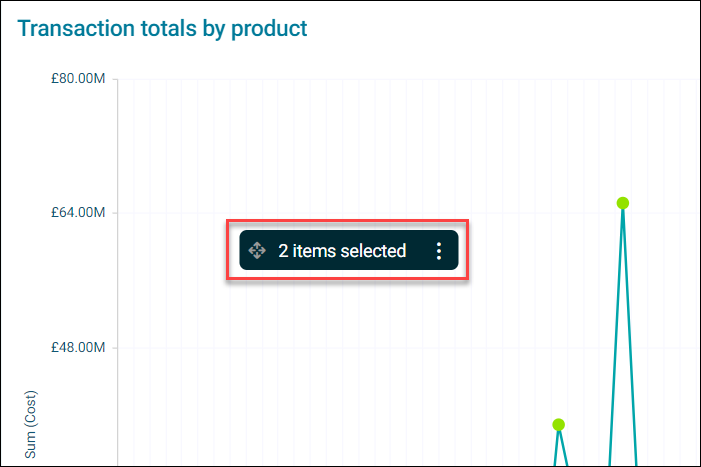
-
Data tables: Display content justification as left aligned by default
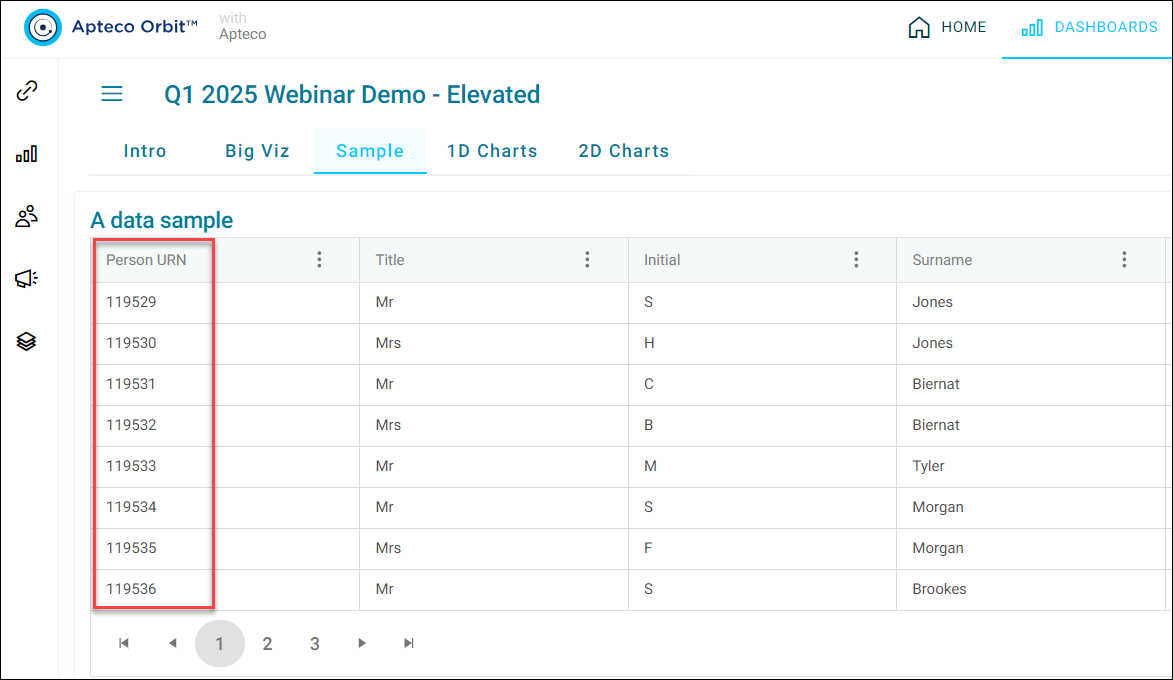
-
Chart mouseover interaction: Has improved, in terms of detail displayed and performance
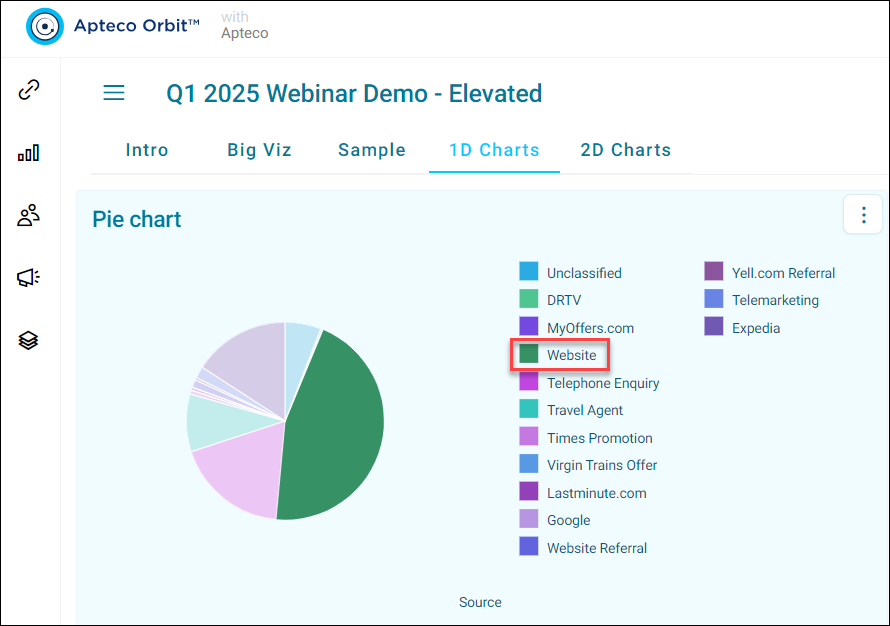
-
Funnel chart labelling: Has improved, with numbers now displayed proportionally
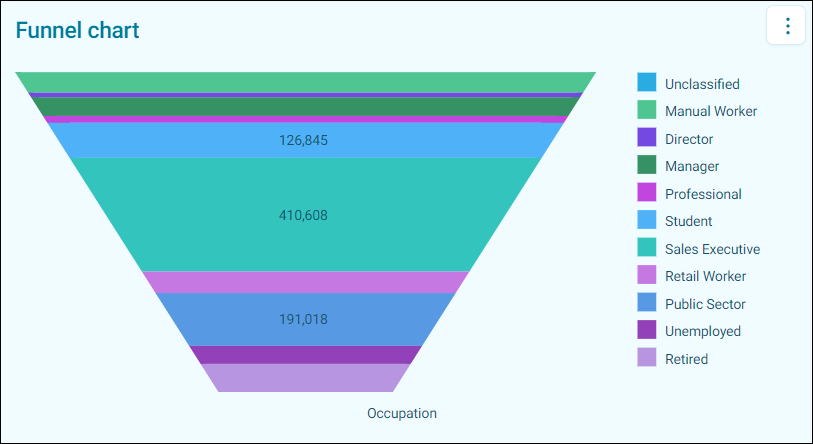
-
Chart legend mouseover: Now interacts more dynamically with your chart

With this foundation in place, we’ll continue expanding our dashboard functionality to give you the best possible visualisation, analysis, and user experience from your data.
Note: If you have any issues with your dashboards after this update, we recommend that your system administrator contacts our Technical Services team for further support.
New features and improvements
Campaigns
Pause/resume moved to option menu
The Pause/Resume button is now in the option menu instead of the campaign header. This keeps the interface clean while still giving you quick access to campaign controls.
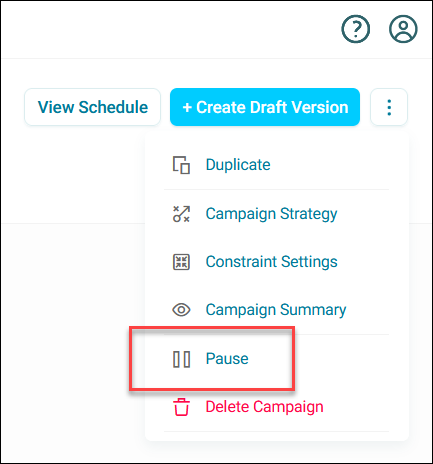
UTM codes for Apteco SMS
You can now track the performance of your Apteco SMS campaigns by manually adding UTM codes to the URLs within your message templates. This allows you to track where your traffic is coming from and gain better insights into the effectiveness of your SMS campaigns in your analytics tools.
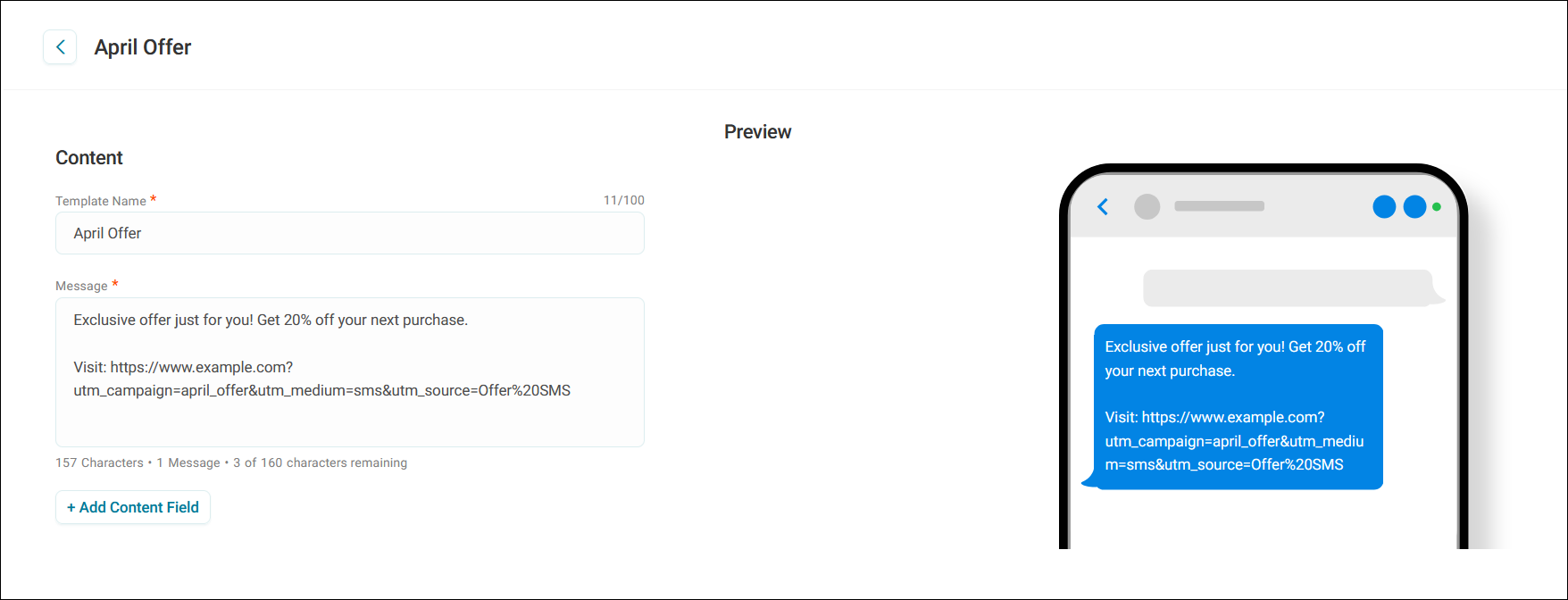
To do this, simply append the UTM parameters (such as utm_source, utm_medium, and utm_campaign) to the end of your URL links.
For more detail, see Apteco SMS.
Audiences
Chart and cube dimension filters in audience workbooks
You now have the option to filter chart and cube dimensions in audience workbooks, making enhanced analysis capability easily accessible.
Finding measure improvements
We've improved how you navigate, search, and find measures in audience workbooks, without losing your current position in the hierarchical measure menu.
Sort order of Selector categories
Orbit now displays selector categories alphabetically, matching the order defined in the FastStats Designer data build process.
Administration
Permissions updates
We’ve made several updates to permissions for administrators. You can now:
-
Manage which users, groups, and systems receive content via the 'share to all' option
-
Control who can see and change their account settings
-
Decide who can use favourites, including who creates and receives favourites
Bug fixes
Dashboards
-
We've fixed an intermittent dashboard sharing issue, causing group dashboard sharing to fail under certain circumstances.
-
Measures using currency variables with a Populated or Count Distinct function now display in general format, rather than as currencies.
Campaigns
-
Singular and Plural Display Name descriptions now function and display correctly on campaign goals and objectives.
25 March 2025
Version 2.1.22
Headline feature: Orbit connect: Additional relationship types
We’re introducing some new relationship types for use in your Orbit connect system.
Relationships are defined by selecting common fields in related data tables. Relationship types define how the data in those tables are joined.
In addition to the originally hidden (but now visible) One-to-Many relationship type, Orbit connect now supports One-to-One and Many-to-One options. Using these new relationship types you can append columns of data by linking additional tables sharing common fields.
You can use these additional relationship types to enhance your original data and increase its suitability for segmentation and analysis purposes by e.g.
-
Adding demographic or geodemographic data to your current records
-
Enhancing product information by matching it with a product code
-
Adding any other data you may want to bring to the system
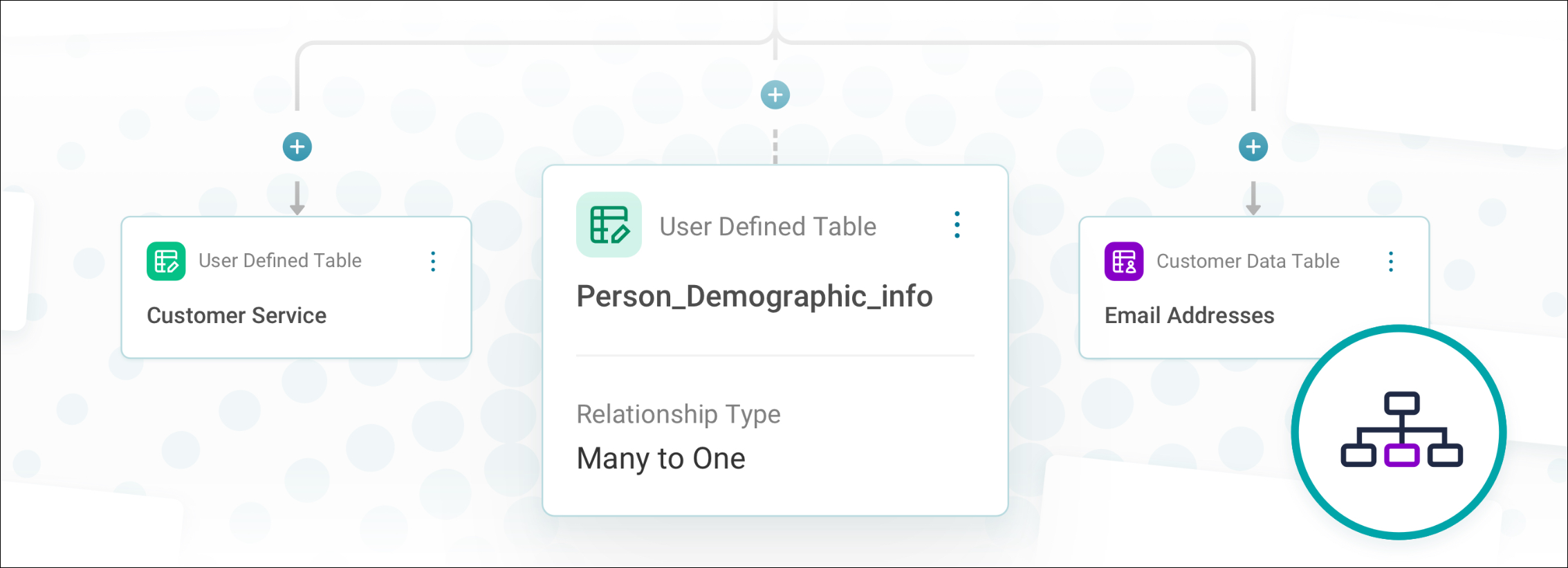
Benefits:
-
More flexibility when setting up, maintaining, and enhancing your system
-
Easily add extra information to the system without spending substantial time redefining it
-
Minimise the amount of necessary data required in each record
-
Add additional data to individuals, sites, products (or any other type of) records, or add geodemographic information to addresses
-
The parent data record doesn’t need to be altered. A single code can be used to efficiently append many additional columns of information to each record, rather than having to store the additional date against **every record** in the original source data (and parent table)
See Additional relationship types.
New features and improvements
Audiences
Audience workbook default chart selection
When you create a new audience from an audience workbook chart, the new audience now defaults to the table of that chart, not the table of the original workbook audience.
Bug fixes
Dashboards
-
Pre-defined dashboard filters using files no longer retain an original file reference after you add an existing/upload a file, and then edit and save your dashboard.
-
When you update an audience or dashboard cube measure, this is now reflected in the description label, as expected.
-
Dashboard text tile notes no longer only left align, you can now also centre and right align notes.
-
We've fixed an issue preventing new a search filter term from appearing along with any already active filter definitions on a dashboard. The blue update icon did not appear and the underlying tile query option also couldn't be selected.
Campaign
-
Deep links to resources now work correctly when logging in via SSO. Previously, after reopening your browser and pasting a saved dashboard link, you were redirected to the Orbit home screen instead of the intended dashboard. Now, after authentication, deep linking takes you directly to the intended correct resource.
-
Logging out of Orbit while working in a journey no longer causes an error.
-
Orbit now correctly authenticates with the API when using the default settings for SignalR campaign stats and status updates. Previously, with experimental API endpoints disabled, an authentication error prevented journey counts from updating as expected.
-
We've fixed an issue where creating a draft version of a campaign journey did not immediately update the audience preview counts, causing inconsistencies when switching between live and draft versions.
11 March 2025
Version 2.1.21
Incoming headline feature: Elevated dashboards
We’ll soon bring the improved edit panels from audiences to dashboards, making dashboard tile definitions clearer, faster, and more consistent. This upcoming elevation of our dashboard technology simplifies training and onboarding of Orbit dashboard end users, making what you learn in one area seamlessly apply to the other.
For more comprehensive detail on the functionality and benefits of elevated dashboards, see our Apteco insider programme.
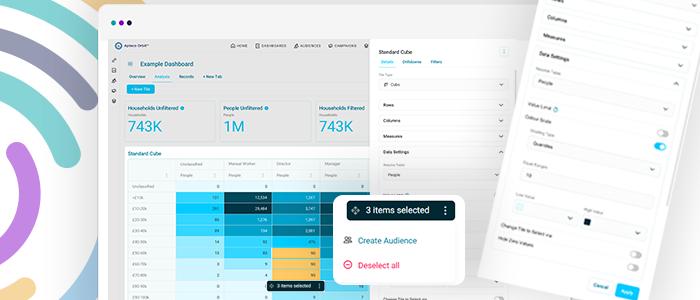
To prepare for the full release of elevated dashboards, we advise that your system administrator makes a few adjustments to your Orbit update schedule and existing dashboard content. We'll continue to update this administrative support information as we approach the full release of elevated dashboards.
For more detail on how to effectively prepare for elevated dashboards, see our elevated dashboards technical update.
Note: With the full release of dashboard elevated technology, if you've received Orbit version 2.1.23, this technical update no longer applies.
If you have any with your dashboards after this update, we recommend that your system administrator contacts our Technical Services team for further support.
New features and improvements
Campaigns
Custom domains for Apteco landing pages
You can now specify a custom domain for landing pages in Apteco Orbit Campaigns when using Apteco email.

With a custom domain, your landing page URLs look more professional and reflect your brand.
For more information about the required DNS record changes, see Landing pages.
Upsert data to Microsoft Dynamics 365 and Salesforce SalesCloud from Orbit campaigns with a PeopleStage channel
You can now upsert data into a defined table in Microsoft Dynamics 365 and Salesforce Sales Cloud directly from an Orbit campaign. This helps keep your CRM data up to date without needing external processes.
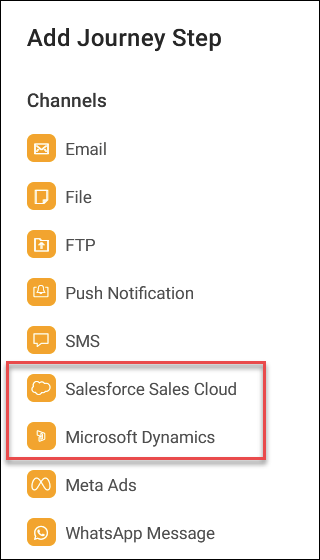
Feature availability: This update does not yet allow full setup within Orbit. You must still create channels in PeopleStage. However, if you already use PeopleStage, you can now run these campaigns in Orbit. The next step will be enabling full data setup and transfer directly within Orbit.
If you use PeopleStage, and these channels are set up in PeopleStage, you can enable them in Orbit to transfer data from Apteco to these platforms. For setup documentation, see below.
The Microsoft Dynamics 365 and Salesforce Sales Cloud channels in Orbit are now controlled by a Preview Switch under Application settings. See Preview features. If you have set up these channels in PeopleStage, you can turn on the switch to use them in Orbit campaigns.
For more detail see:
Dashboards
Dashboard list search filter
You can now quickly and effectively search for a dashboard using the new dashboards list search filter.
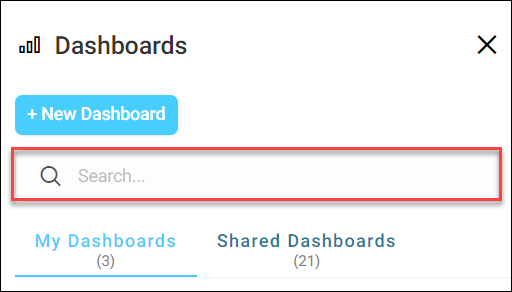
This search filter feature allows you to find a specific dashboard from your list of available dashboards in My Dashboards and Shared Dashboards.
See Dashboard list search filter.
General
New training links and updated Home page design
We've revised our selection of Orbit Home page links for easier access to latest features, Apteco help, and now also our on-demand training resources.
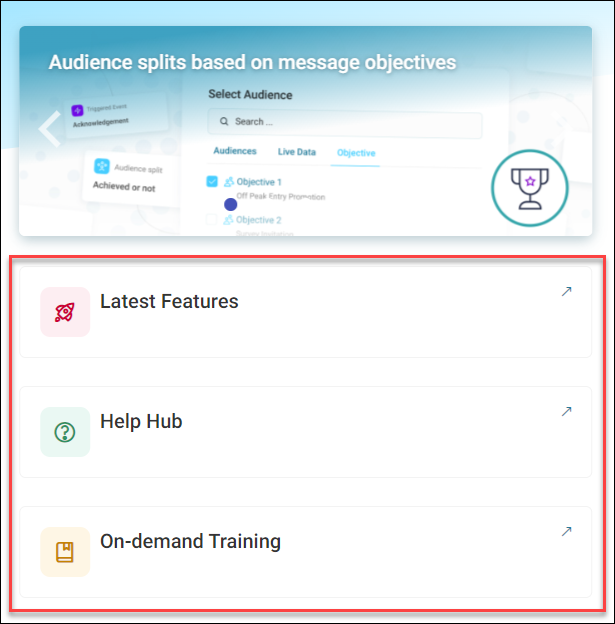
The home page links now include:
-
Latest Features: Takes you to the Orbit release notes, where you’ll find detailed breakdowns of recent enhancements and bug fixes, along with links to additional resources.
-
Help Hub: Your go-to resource for user guides, release content, and technical documentation. If you need help using Apteco software, you’ll find your answers here.
-
On-demand Training: As part of our ongoing work to provide fully flexible, 24/7, globally accessible training for Apteco users, our on-demand training provision packs learning content and expert knowledge into an engaging series of video modules. Simply select and purchase your course to get started, with 30 days’ unlimited access to complete your learning.
Bug fixes
Dashboards
-
We've fixed an issue where selecting the dashboard that you're already on from your home list would then present you with a blank dashboard, without any tiles.
-
Target tiles now display target value percentages multiplied by 100, as expected. Previously, when creating a target tile using a percentage calculation using a fixed target, the target was rounded up and expressed as a decimal with a percentage symbol added to it.
-
We've fixed an issue where search filters were not saved when first added to a new dashboard. When you created a new dashboard, added a tile and search filter, and saved, the search filter would not save at the first attempt.
Campaigns
-
Undefined Email channel error messages now display a 'Show details' option, providing a detailed breakdown of the error. These details are especially useful to our Technical Services team when contacting them for further assistance with your error.
-
You no longer receive a null error message when copying and pasting an unnamed audience or interaction split. You can now copy unnamed steps and display step type in place of the name.
26 February 2025
Version 2.1.20
Headline feature
Audience splits based on message objectives
The Orbit journey builder now includes audience split functionality based on message objectives. This feature automatically segments your audience, sending them along different journey paths depending on how they interacted with your message. Instead of manually creating segmented audiences, you can define journey branches that adapt your customers’ behaviour.
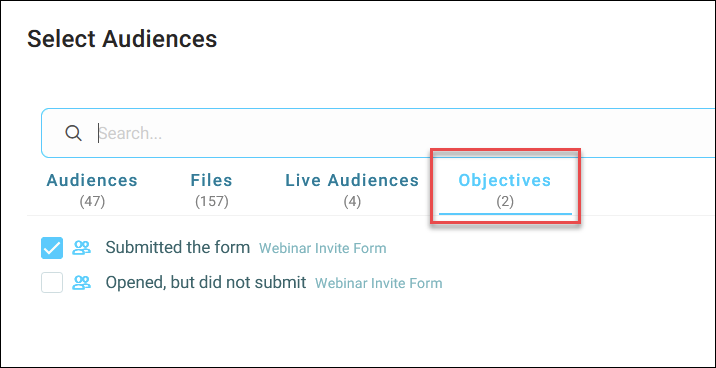
With this feature, you can:
-
Define multiple journey paths based on whether a recipient met a message objective, such as submitting a form
-
Automatically send customers along relevant paths without manually creating segmented audiences
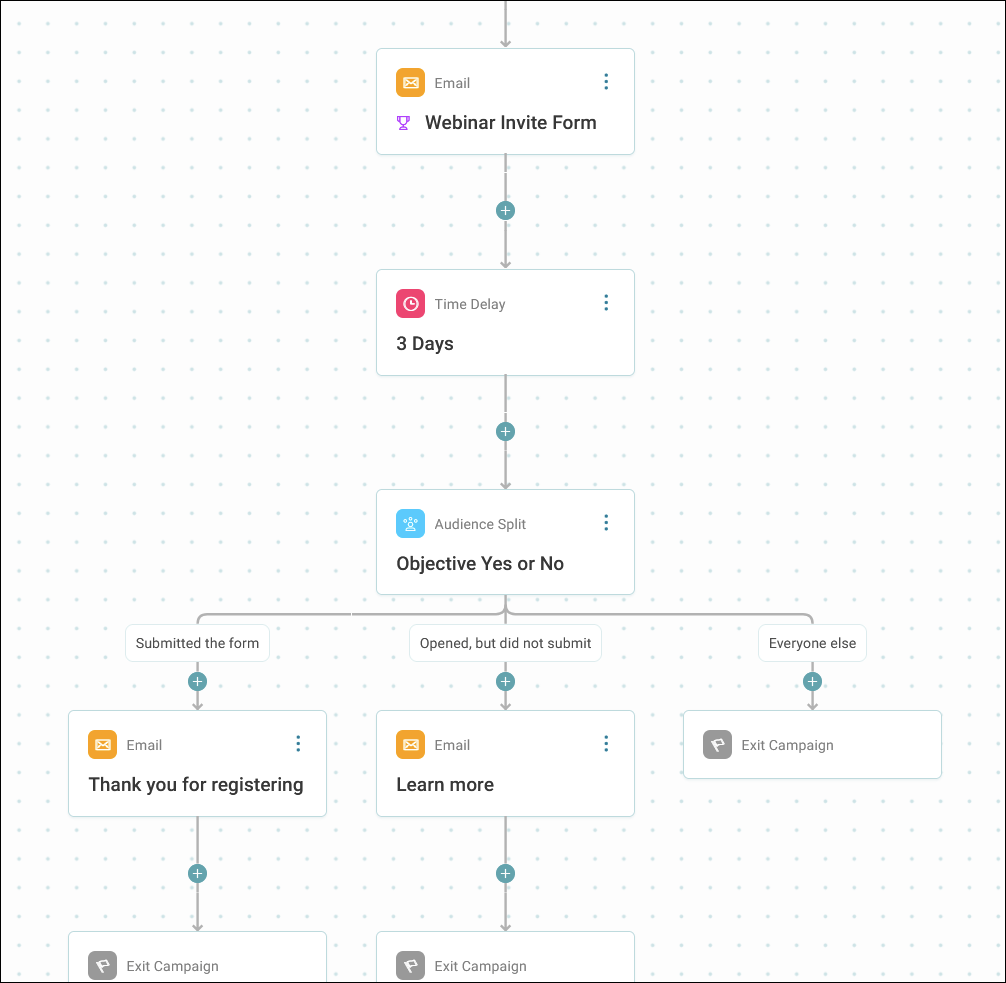
Key benefits
-
Tailor follow-ups based on actual customer interactions
-
Increase engagement by responding dynamically to user actions
-
Reduce manual effort and let the journey handle segmentation
For more detail, see Audience splits.
New features and improvements
Audiences
Export cubes to Excel
You now have the ability to export an audience workbook cube to Excel. You could already do this in dashboards, but is now available in audiences as part of our ongoing alignment between these two areas of Orbit.
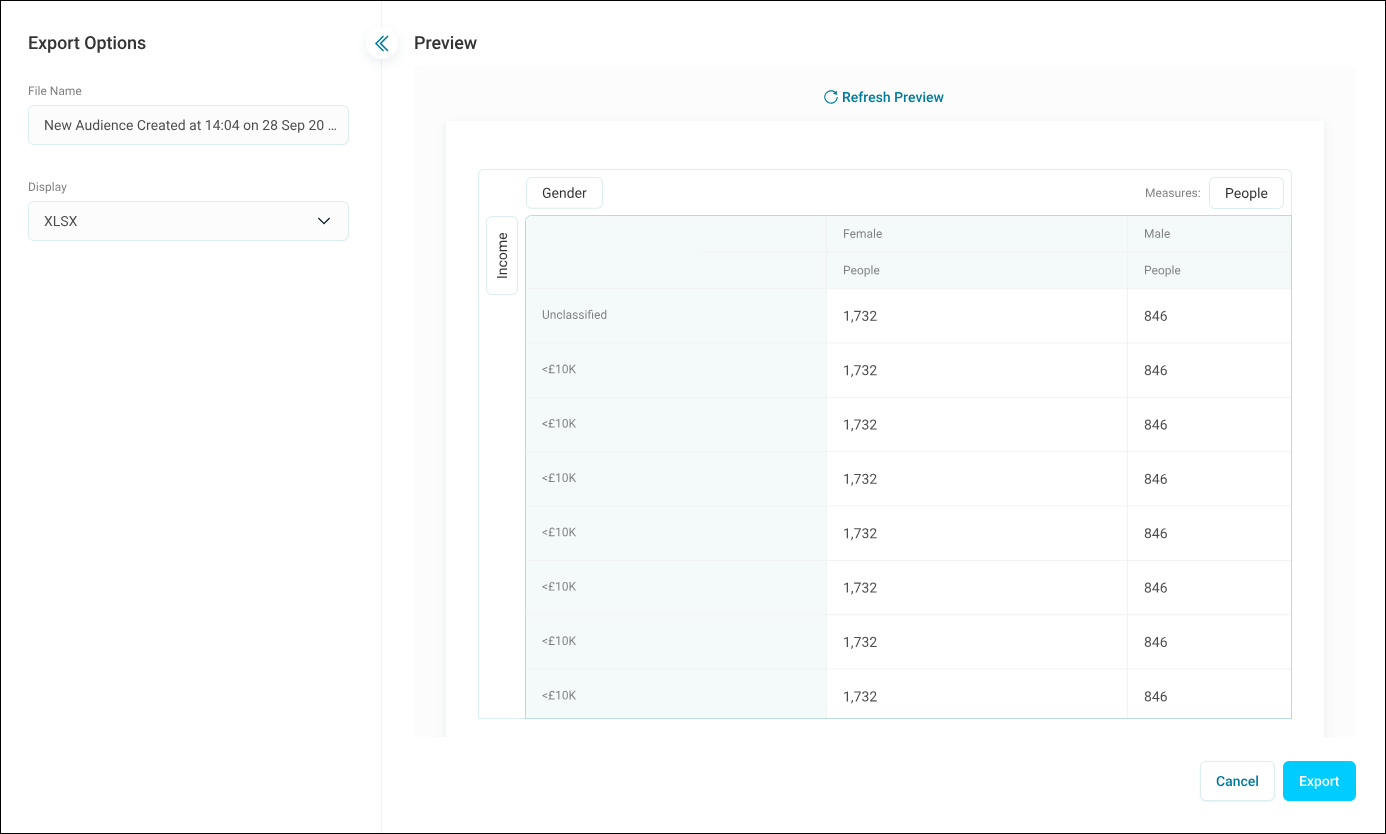
For more detail, see Exporting an audience workbook cube.
Campaigns
Improved licensing visibility for campaign goals and message objectives
We've updated the Orbit journey builder to ensure you only see relevant UI elements based on your current licence:
-
Campaign Strategy in the journey option menu no longer appears if you don’t have a Campaigner licence or above.
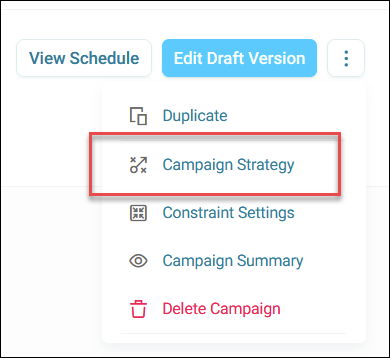
-
The Objectives section in the message step side panel no longer appears if you don’t have a Campaigner licence or above.
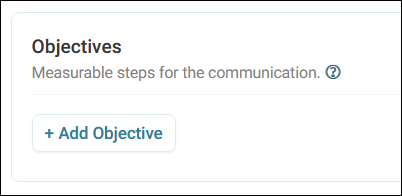
These changes improve clarity for users with the Broadcaster bundle who don’t have access to goals or objectives.
For more detail on Apteco software licensing options, see Flexible pricing bundles.
For more detail on goals or objectives, see Campaign goals and Message objectives.
Bug fixes
Connect
-
The view connection string button no longer overlaps the actual text of the connection string, when configuring data sources in Orbit connect.
Campaigns
-
We've fixed an issue causing campaign goals to disappear from your journey when reopening the side panel.
-
You can now successfully delete a campaign goal as expected.
13 February 2025
Version 2.1.19
Headline feature
Multi-dimension charts in audience workbooks
We’ve now further extended audience workbook visualisations to include multi-dimension charts.
Multi-dimension charts are a combination of column, bar, line, and area charts, that can be clustered, stacked, stacked 100%, or a combination (Combo) thereof:
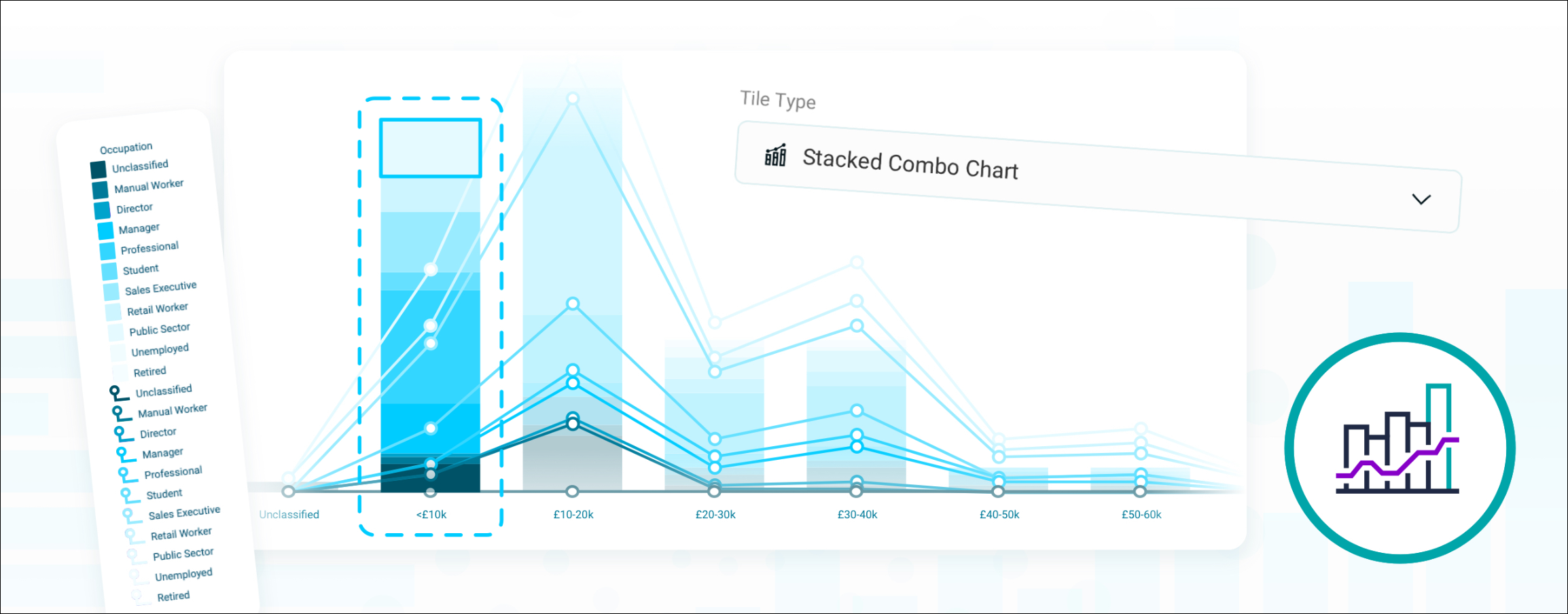
These full-screen charts also now take advantage of our fully redesigned properties side panel.
Two dimensions and one measure:
-
Clustered column
-
Stacked column
-
100% stacked column
-
Clustered bar
-
Stacked bar
-
100% stacked bar
-
Clustered line
-
Stacked area
-
100% stacked area
Two dimensions and two measures:
-
Clustered combo
-
Stacked combo
-
100% stacked combo
This enhancement further aligns audiences and dashboards, as we work towards providing you with a seamless analytics user experience. We want you to be able to access all the tools you need ‘in a pinch’, for ease of use, wherever you are in Orbit.
See Multi-dimension charts in audiences.
New features and improvements
Campaigns
Using saved FastStats expressions in campaign message personalisation
You now have the ability to use any saved FastStats expressions as personalisation content fields in your Orbit campaign messages.
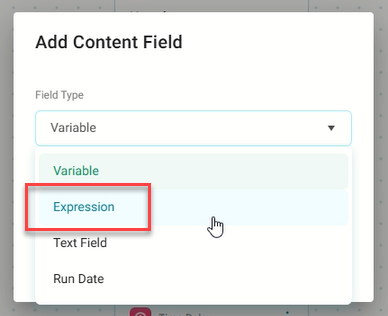
Using pre-defined FastStats expressions into your Orbit campaigns enables more dynamic and customised content.
This feature is useful for:
-
Linking fields for specific campaigns
-
Creating offer codes
-
Defining image sets based on segments
-
Writing conditional statements for personalised content
Note: Available for Analyser bundle and above.
For more detail, see the FastStats help content for expressions and FastStats expressions in Orbit message personalisation.
Bug fixes
Connect
-
We've fixed a bug requiring datetime database columns to be converted before they're loaded correctly. When using an SQL, Snowflake, or PostgreSQL data source with a datetime, the data wouldn't load to the EAV correctly, and would need to be represented at source.
-
You will no longer encounter a timeout when replacing or updating a data source, causing your process to crash without an error message being displayed. This fix addressed an error messaging issue in the connect user interface.
Dashboards
-
Categorical colours are now cached per session across themes, as well as systems and variables. This ensures that pie charts with different dashboard themes retain their correct colours after refreshing Orbit.
-
We’ve fixed a bug preventing sparse cube results from not being drawn and displayed in the UI. In dashboards, when you made a cube using Booking Date vs Postcode, in the inspector cube results were present but the UI stated ‘No data to Display’.
Audiences
-
A range error no longer occurs when you add dimensions with many categories to a cube. This range error would previously cause a crash after adding a second dimension to your cube.
-
Single dimension and combination (combo) charts now have greater ability to automatically increase the spacing of data labels, preventing overlapping issues occurring with chart labels presenting a lot of detail.
-
We’ve found and fixed an issue that caused incorrect results when you selected 'Omit Unclassifieds' on a cube that has multi-dimensions on the same axis. Extra bands/cells were incorrectly displayed outside your original selection, also affecting counts on any follow up audiences created from these extra cells.
General
-
When downloading large exported files from Orbit, you no longer encounter a timeout before completion. Previously, exporting a file of around 100MB could cause the process to stop without downloading the file to your browser.
-
Single sign-on (SSO) now works successfully through OpenID Connect, even if your Base URL parameter is blank. Previously, switching the protocol to SAML and back to OpenID Connect could leave Base URL empty, causing login failures.
29 January 2025
Version 2.1.18
Headline feature
Expanded audience counts in campaign journeys
We’ve enhanced the audience visibility in Orbit’s journey builder, giving you deeper insights into how your campaign logic affects audience sizes. You can now view detailed audience counts in both draft and published campaign modes, making it easier to refine and evaluate your campaigns.
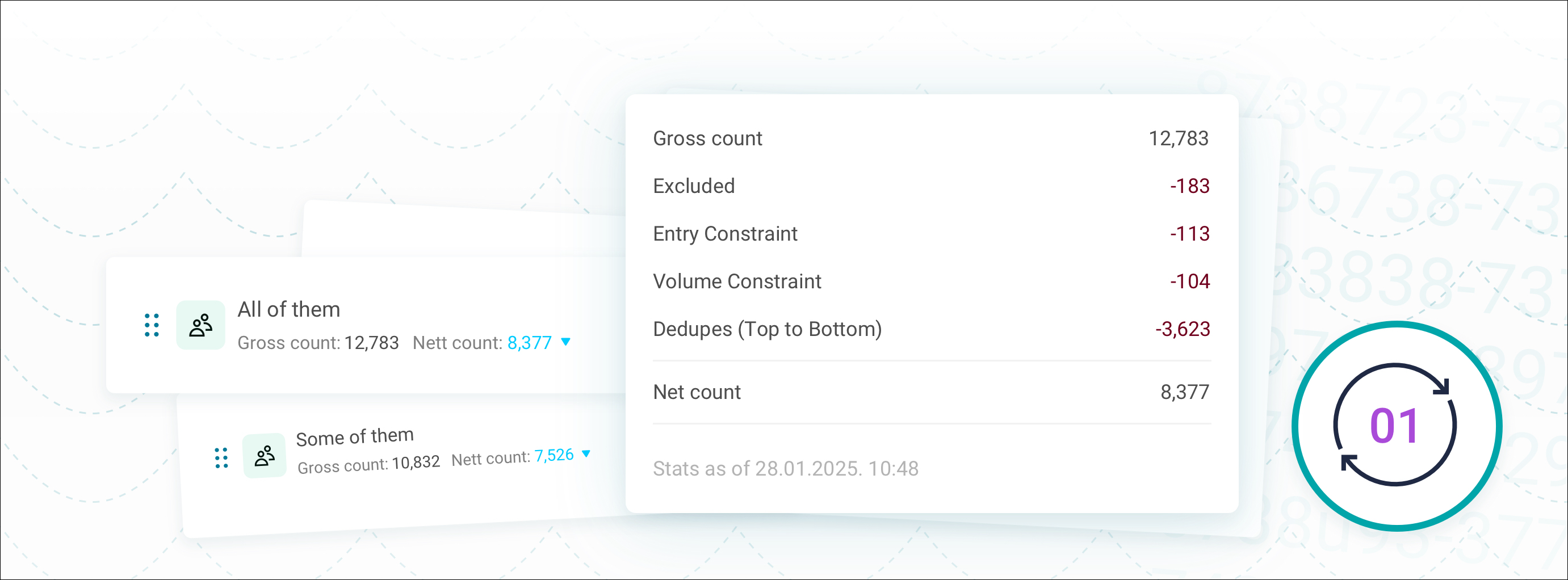
Key improvements:
-
Audience counts in draft mode: See gross, net, and drop counts while working on draft campaigns, not just after publishing.
-
Detailed breakdown of drops:
-
Exclusions: Individuals removed due to exclusion rules
-
De-duplication: Overlapping individuals excluded from multiple groups
-
Volume constraints: Limits applied to the number of individuals in the campaign
Note: These include any campaign volume constraints and target segment limits.
-
Entry constraints: Restrictions from contact strategies, such as "one person per campaign per month"
-
Enhanced audience counts improve transparency and efficiency by showing how exclusions, constraints, and strategies impact your audience. Detailed breakdowns of gross, net, and reduced counts are visible in the Target segment side panel, with timestamps to track when figures were calculated. You can refine your audience in draft mode and trust the updated counts to reflect changes accurately, streamlining your campaign-building process.
For more detail, see Adding audiences.
New features and improvements
Campaigns
Campaign-linked dashboards
Introducing campaign-linked dashboards, a powerful way to track and analyse marketing performance directly from your campaigns. These dashboards function like regular ones but come pre-populated with key campaign metrics, saving you setup time. Whether you need real-time insights or periodic analysis, they adapt seamlessly to your reporting needs.

Use a Tracking Dashboard to monitor live email campaign responses and ROI, making quick adjustments. For strategic reviews, create a Reporting Dashboard to assess segmentation performance and revenue trends in quarterly reports. Both dashboard types are fully customisable, enabling tailored insights with added metrics, filters, and themes.
Key benefits:
-
Get started quickly with pre-configured metrics like communications, recipients, and revenue, saving you setup time
-
Flexibility to customise dashboards by adding data, filters, and themes for tailored insights
-
Data integration that supports real-time SQL data for immediate updates or FastStats data for detailed reporting
![]()
Campaign-linked dashboards simplify performance tracking, helping you make data-driven decisions faster. Share and refine them with your team for maximum impact.
For more detail, see Campaign-linked dashboards.
Audiences
Audience as a cube dimension
You can now use an audience as a dimension in audience workbook cubes. This allows you to further analyse an existing audience workbook cube by switching out a dimension, to use an audience as a dimension ‘on-the-fly’.
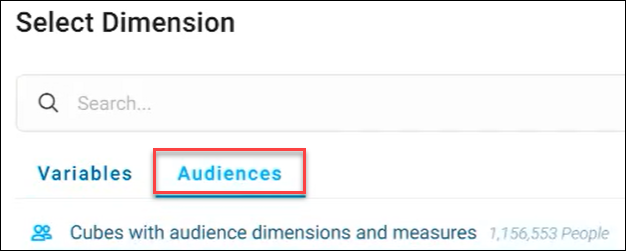
For example, you could take an existing audience with a dimensions of region and gender, then switch out the gender dimension for an audience dimension of respondents. This new audience dimension allows you to display a breakdown of people who have or have not responded to your campaign, drilling further down into your original audience and gaining additional insight into your respondents.
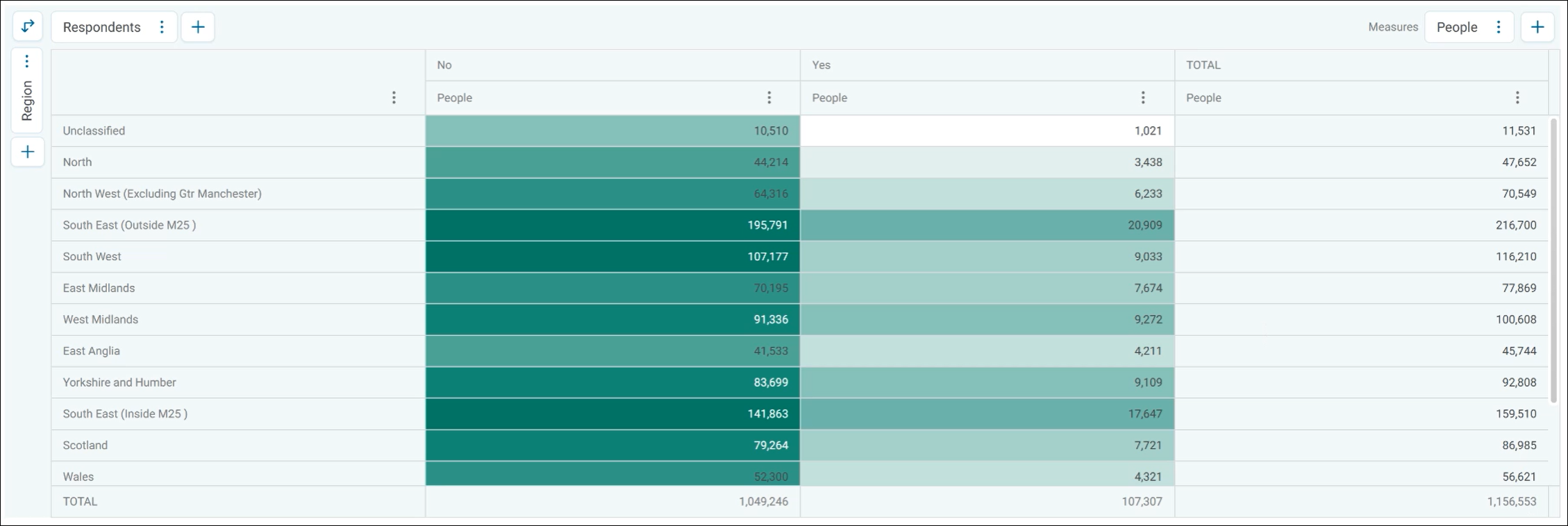
For more detail, see Audience as a cube dimension.
Bug fixes
Campaign
-
Personalisation parameters in push notifications were not being replaced with corresponding audience field values. The replacement logic now correctly substitutes variables like
{{LastName}}with actual values.
Dashboards
-
Number card targets using a previous period now produce correct results, as expected. Previously, a target tile date comparison with a dynamic date range of ‘The Last Month’ could produce an overlap of one day from the source period to the comparison period.
Connect
-
We've resolved an issue that prevented certain names from being used for data sources. Previously, if a name contained special characters (e.g., symbols), the dialog would close when you clicked Create, without displaying a warning or creating the data source.
14 January 2025
Version 2.1.17
Headline feature
Message objectives: Track and optimise campaign performance
Campaign objectives now enable you to set specific goals for each message in your campaigns, allowing you to track their real-time performance. With this feature, you can easily monitor key actions, such as registrations, purchases, or app downloads, and assess how individual messages contribute to your overall campaign goals.
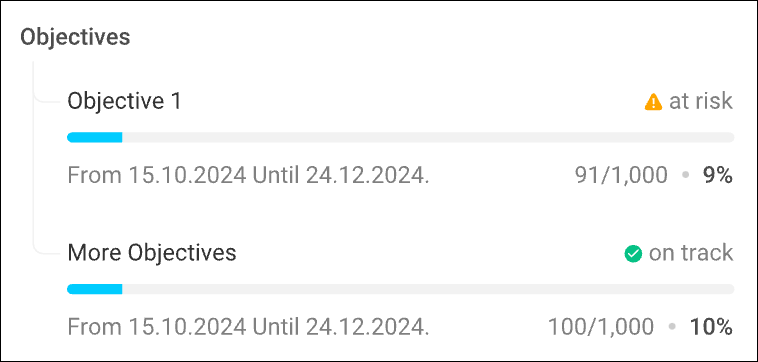
Key benefits:
-
Automatically track responses to monitor actions for each message in real-time
-
Set multiple calls to action to track several objectives within a single message
-
Measure revenue impact to assess the financial contribution of message responses
-
Set target timeframes for each objective that validate automatically
-
Leverage flexible data sources for comprehensive tracking across various data tables
Campaigns often feature multiple objectives for each message. For instance, you can track both pre-orders and event registrations within the same message, helping you evaluate each call to action individually.
Note: This feature is available with a Campaigner bundle and above.
Note: This feature is dependent on the Apteco software Q4 release.
For more detail, see Message objectives.
New features and improvements
Campaigns
Stop all campaigns
You now have the ability to stop all your Orbit campaigns. This acts as a failsafe to instantly halt all active campaigns.

You can then resume your campaigns, with each returning to its prior state and schedule. This feature is ideal for addressing critical issues like failed data builds or ESP outages with immediate action to prevent errors or incorrect messaging.
For more detail, see Stop campaigns.
Push notifications
You can now use push notifications as a channel in Orbit campaigns. This new channel type allows you to engage with your audience directly through their devices, delivering timely and targeted messages across your multi-channel campaigns.
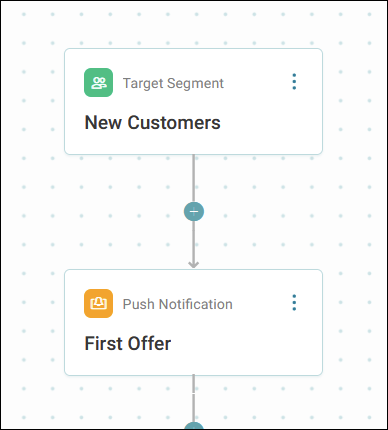
Key benefits:
-
Instant delivery: Ensure your message reaches your audience in real time
-
High visibility: Notifications appear directly on a device’s screen, bypassing cluttered inboxes
SMS template builder appears with SMS channel
The SMS template builder is now displayed for use when an SMS channel has been set up in Orbit. This update applies to all SMS integrations.
View campaigns you’re not licensed to use
As a campaign user, you can now view a campaign that contains features you don't have a licence to use. However, you cannot use any features you’re not licensed for or save any changes you make.
Audiences
Value display limit in audience visualisations
In audience visualisations, you can now choose to show all values or limit the number of values displayed to the top or bottom n values.
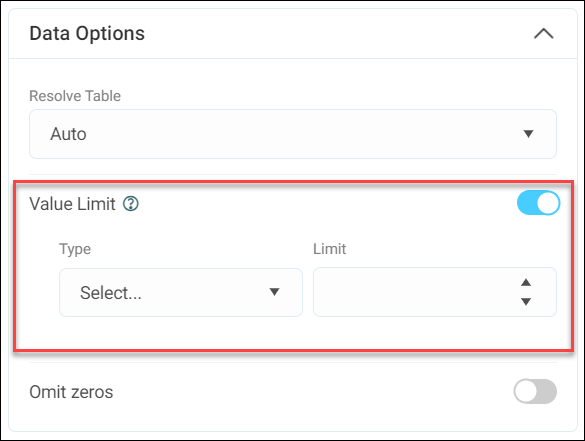
For text variable dimensions, the option to use category display is now removed, and value display is the only available option.
This value display setting is now configurable at the overall visualisation level, not per individual dimension.
See Value display limit.
Omit zeros set to true by default
We’ve changed the way that omit zeros works for donut, pie, and funnel charts in audience workbooks. Omit zeros is now set to true by default for improved user convenience.
Administration
Folders tab for file upload
System administrators now have access to a folders tab on the file upload UI, enabling more efficient addition/deletion of file directories.
Bug fixes
Campaigns
-
When naming constraints, you now retain the changes you've made previously.
-
Swapping between campaigns on a slow connection no longer causes diagram errors to occur.
Dashboards
-
Dashboard row filters applied to a user/group/system no longer cause a timeout on API calls when fetching varCodes.
Audiences
-
We've fixed an issue preventing audience workbook cubes from displaying the correct percentage option.
Administration
-
We’ve found and fixed an issue that prevented the system availability monitor being correctly created for instances hosted within Apteco Cloud.